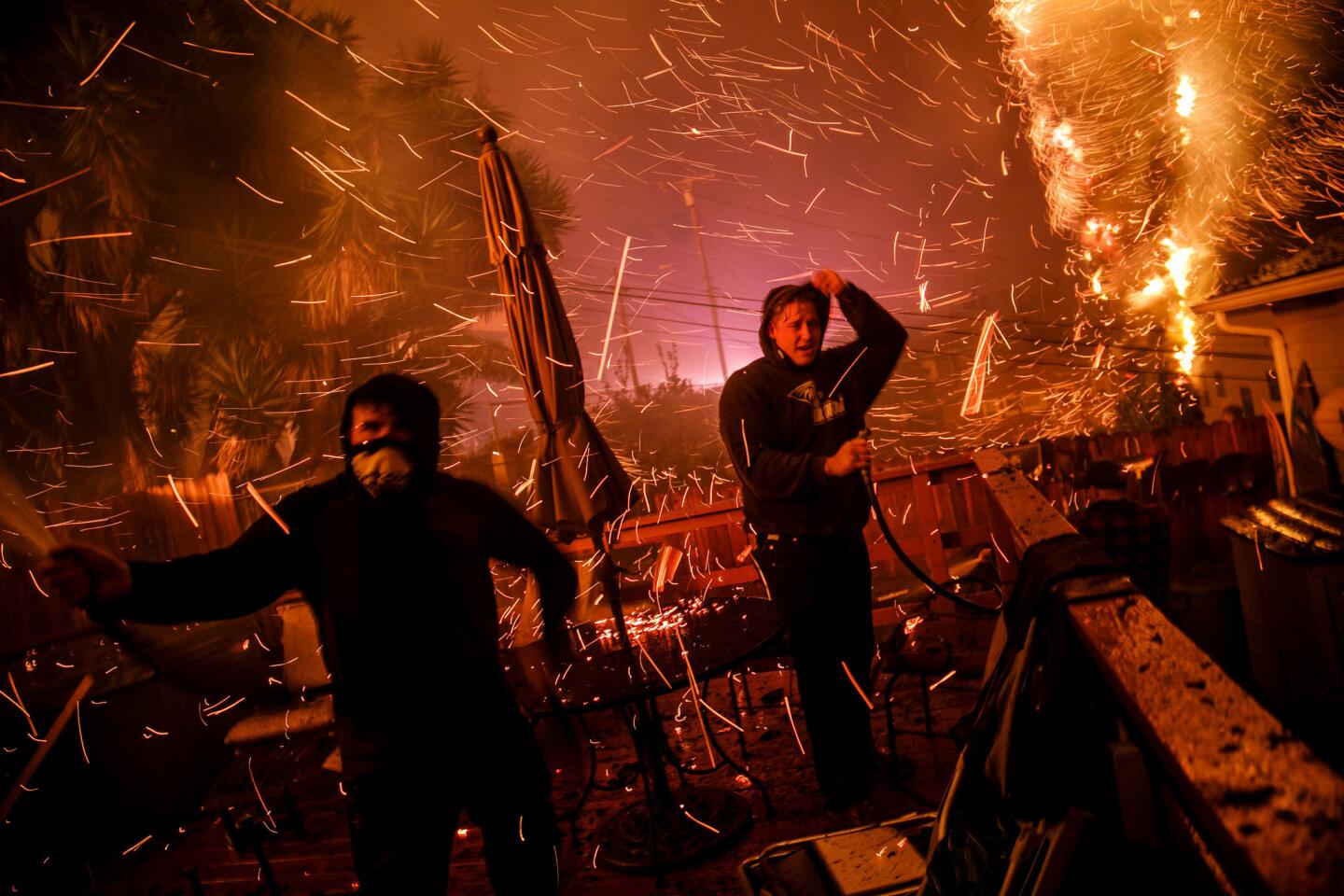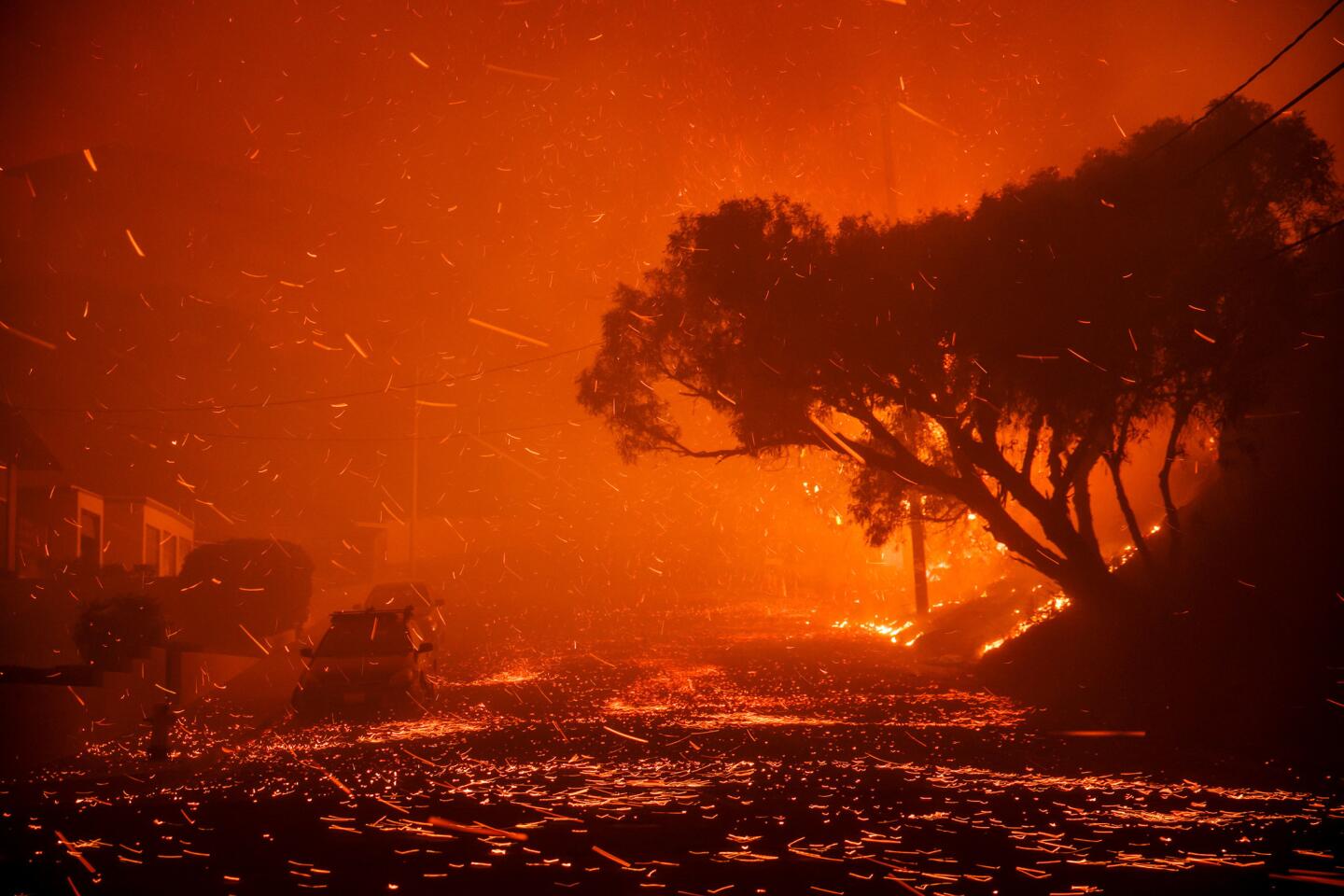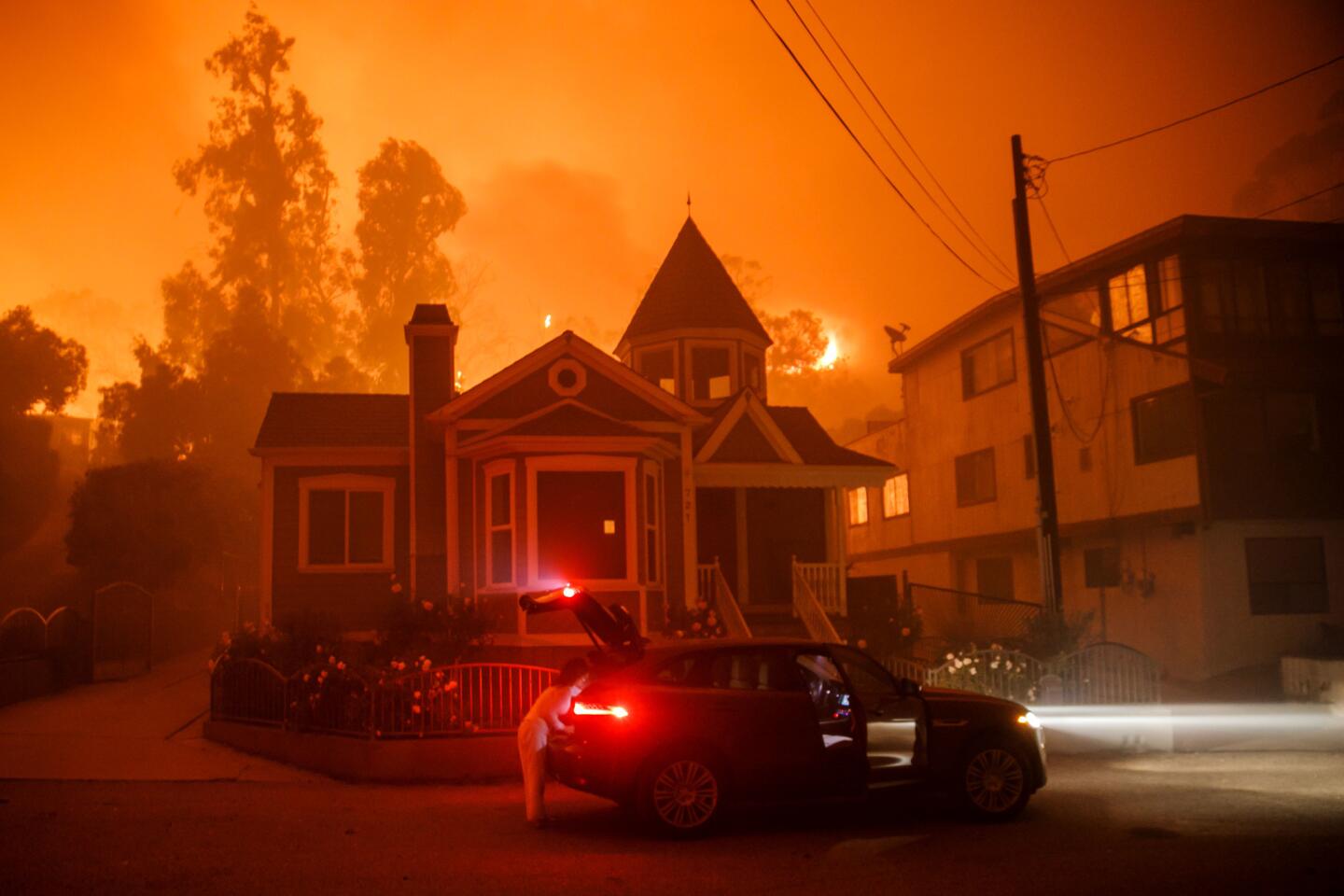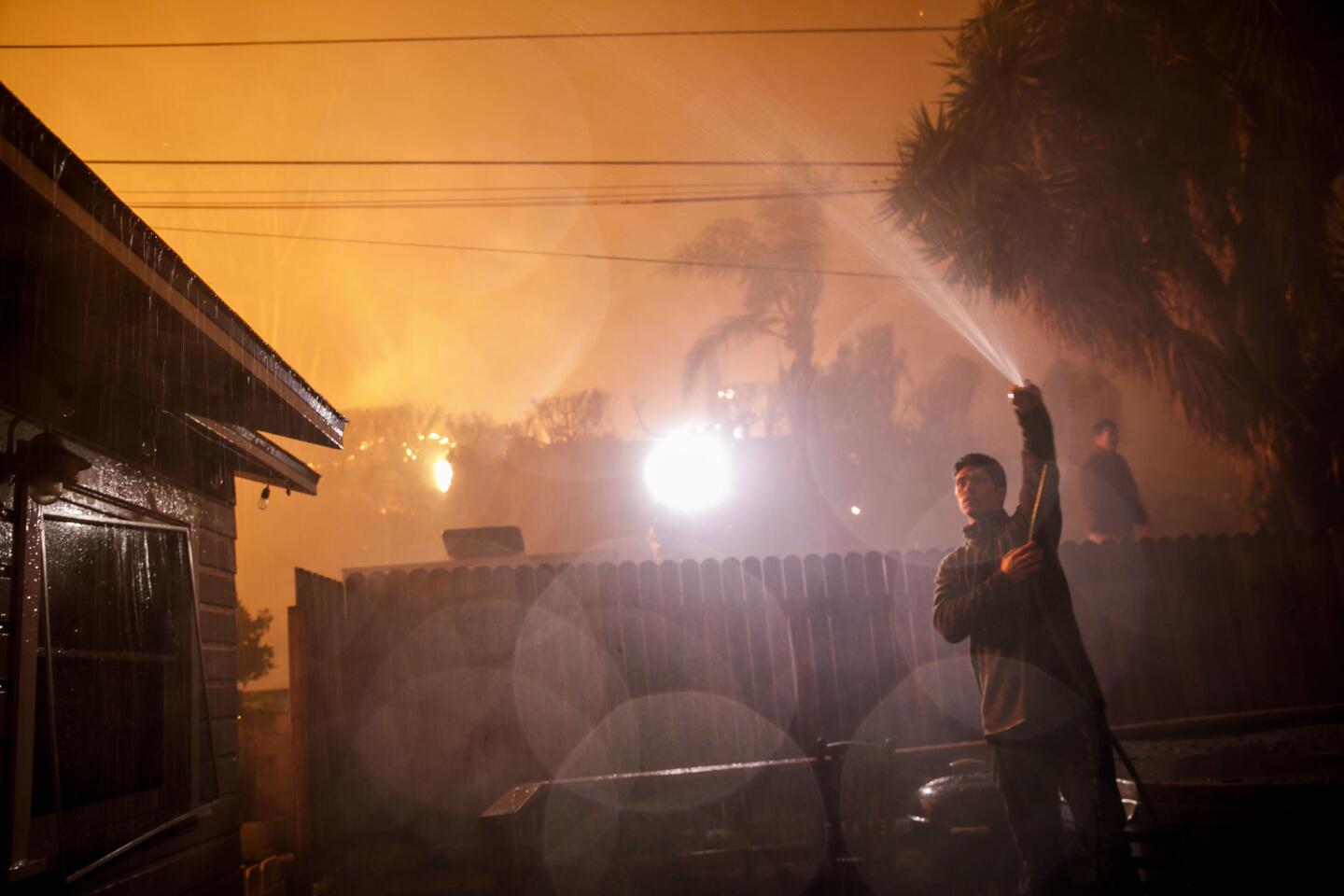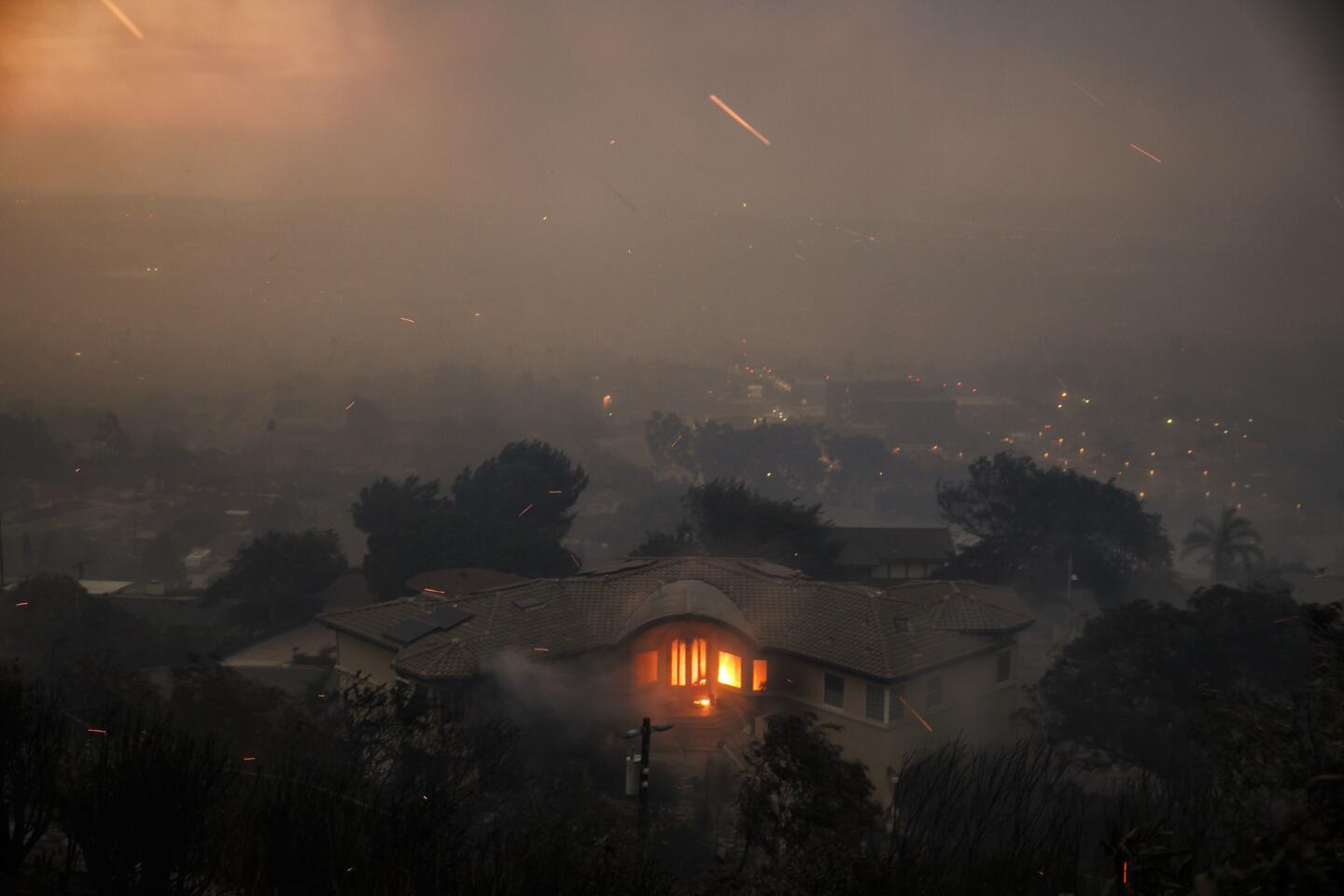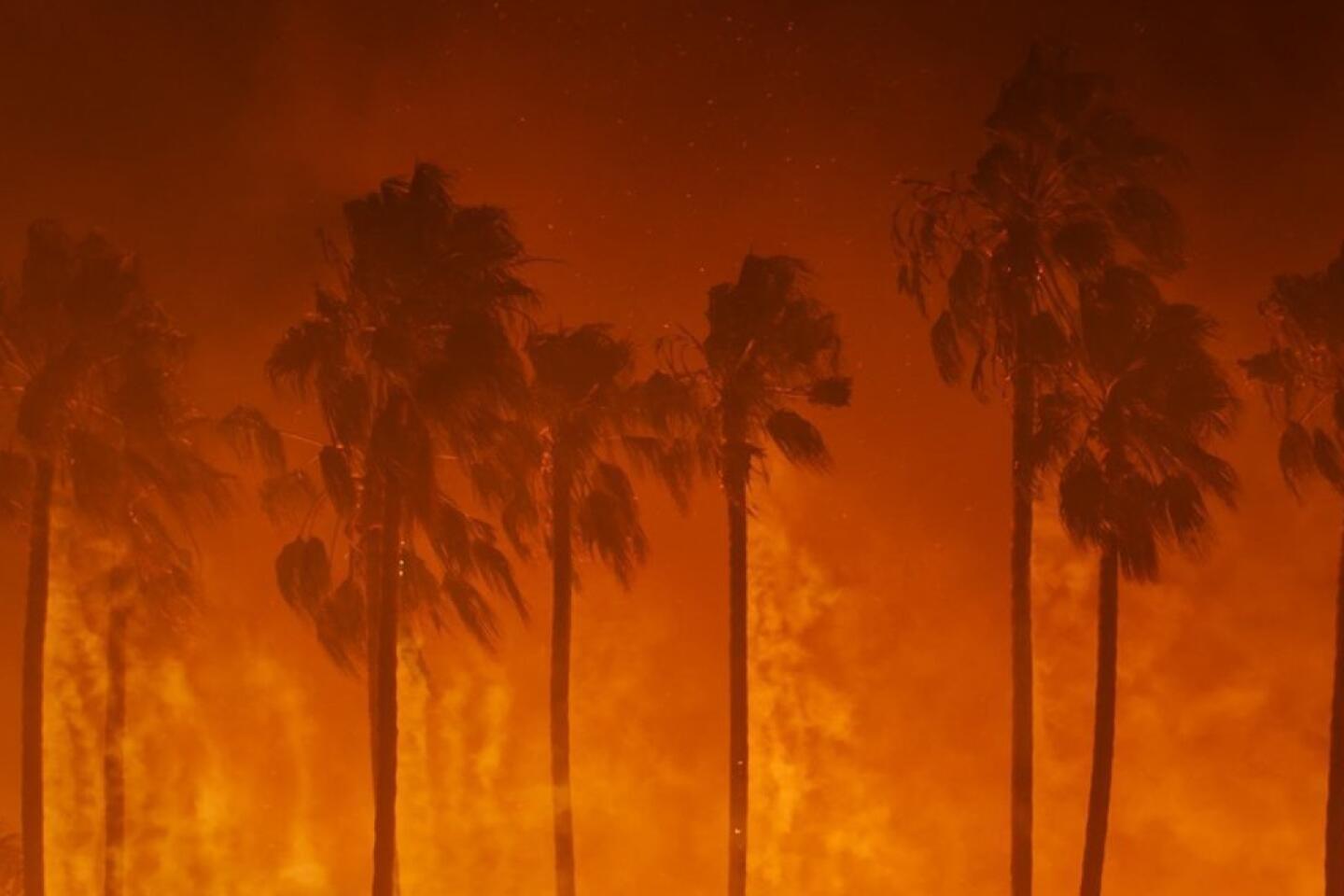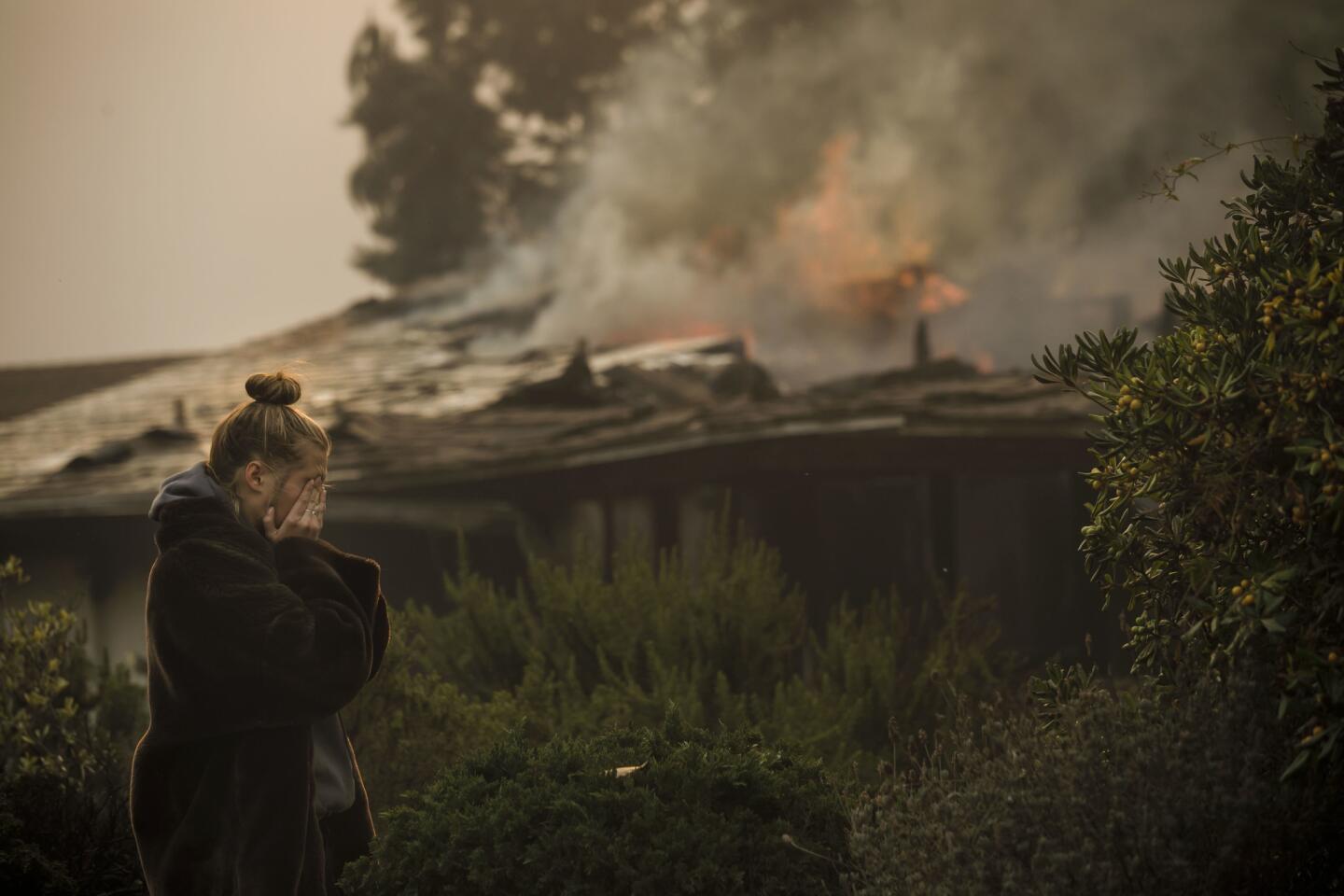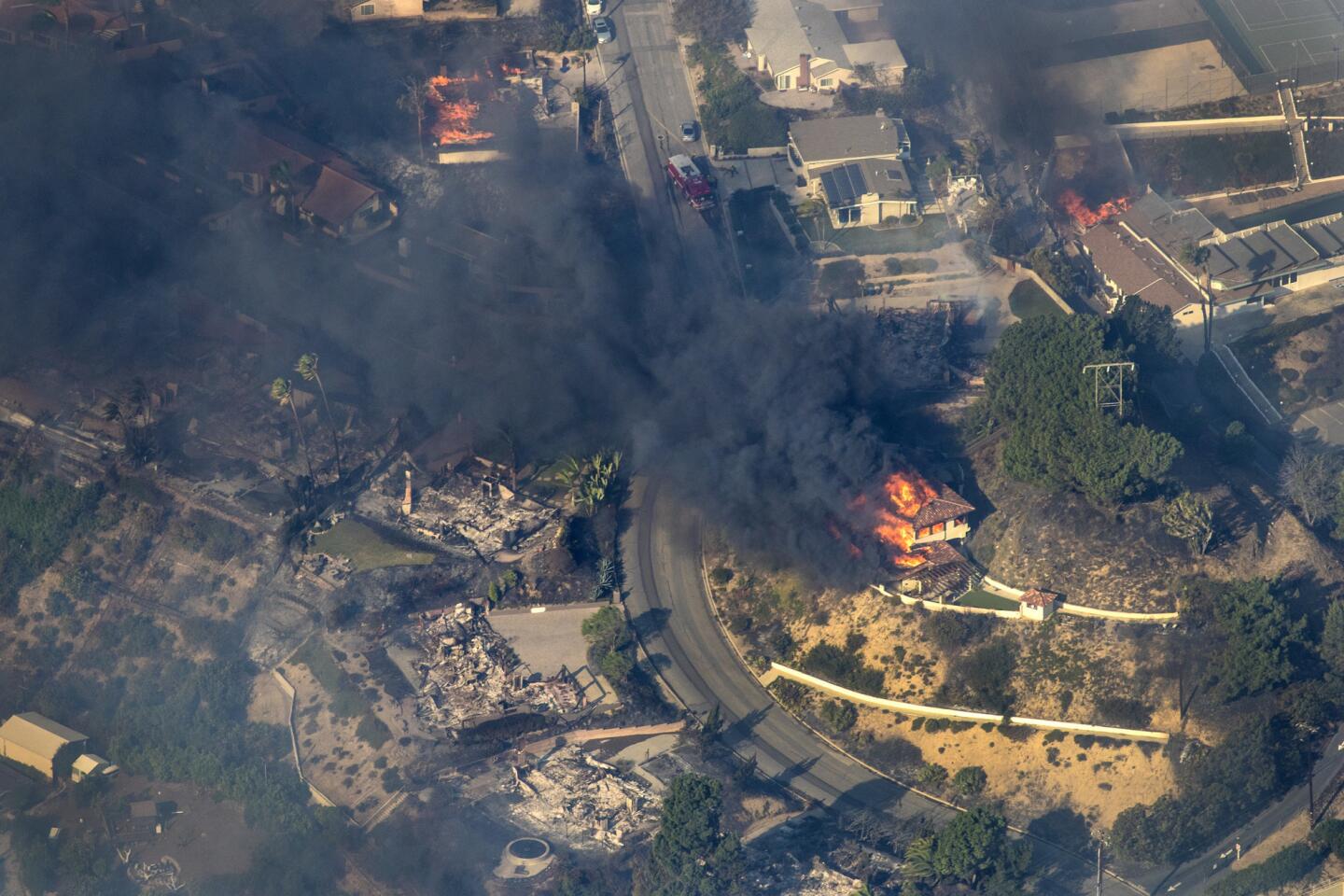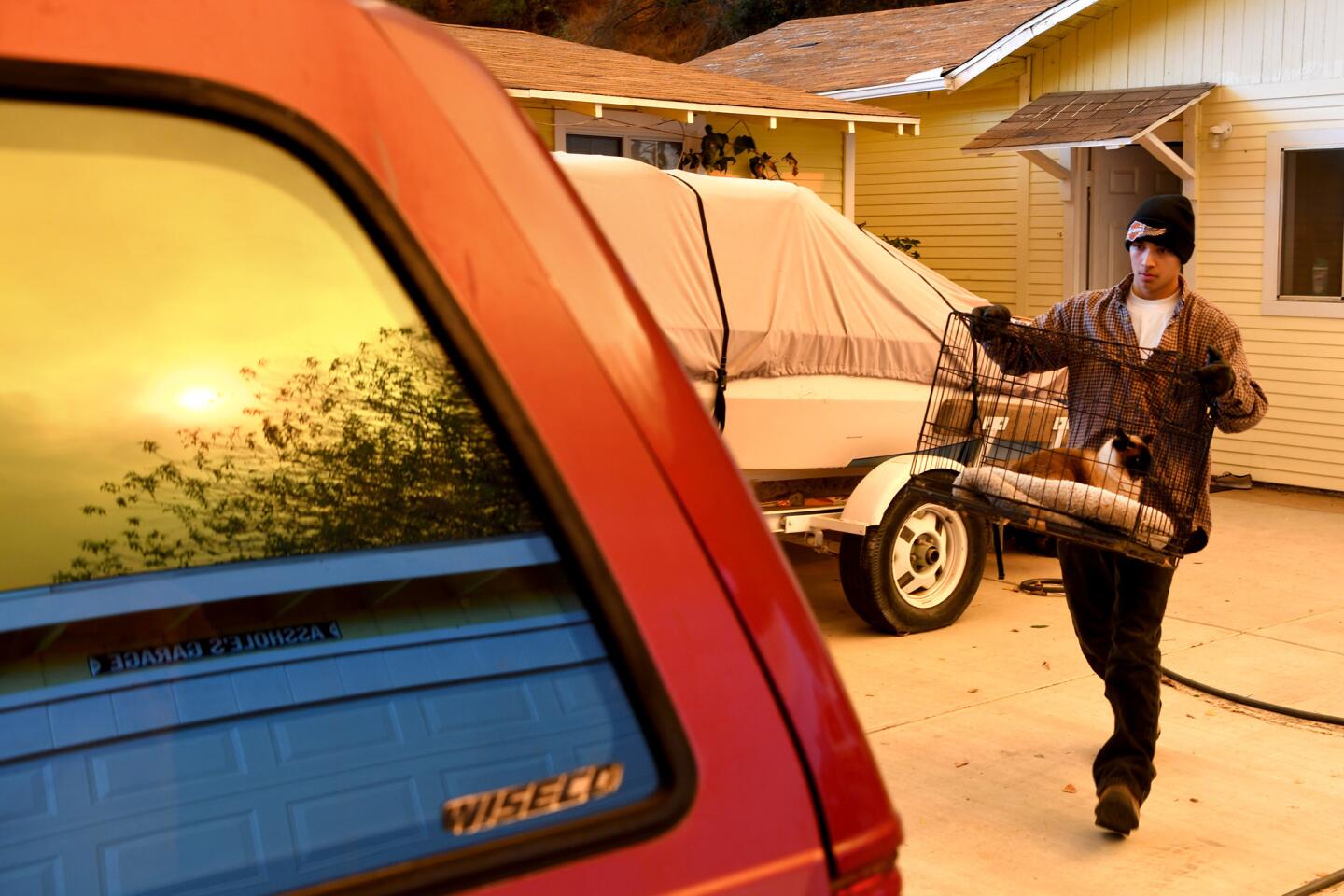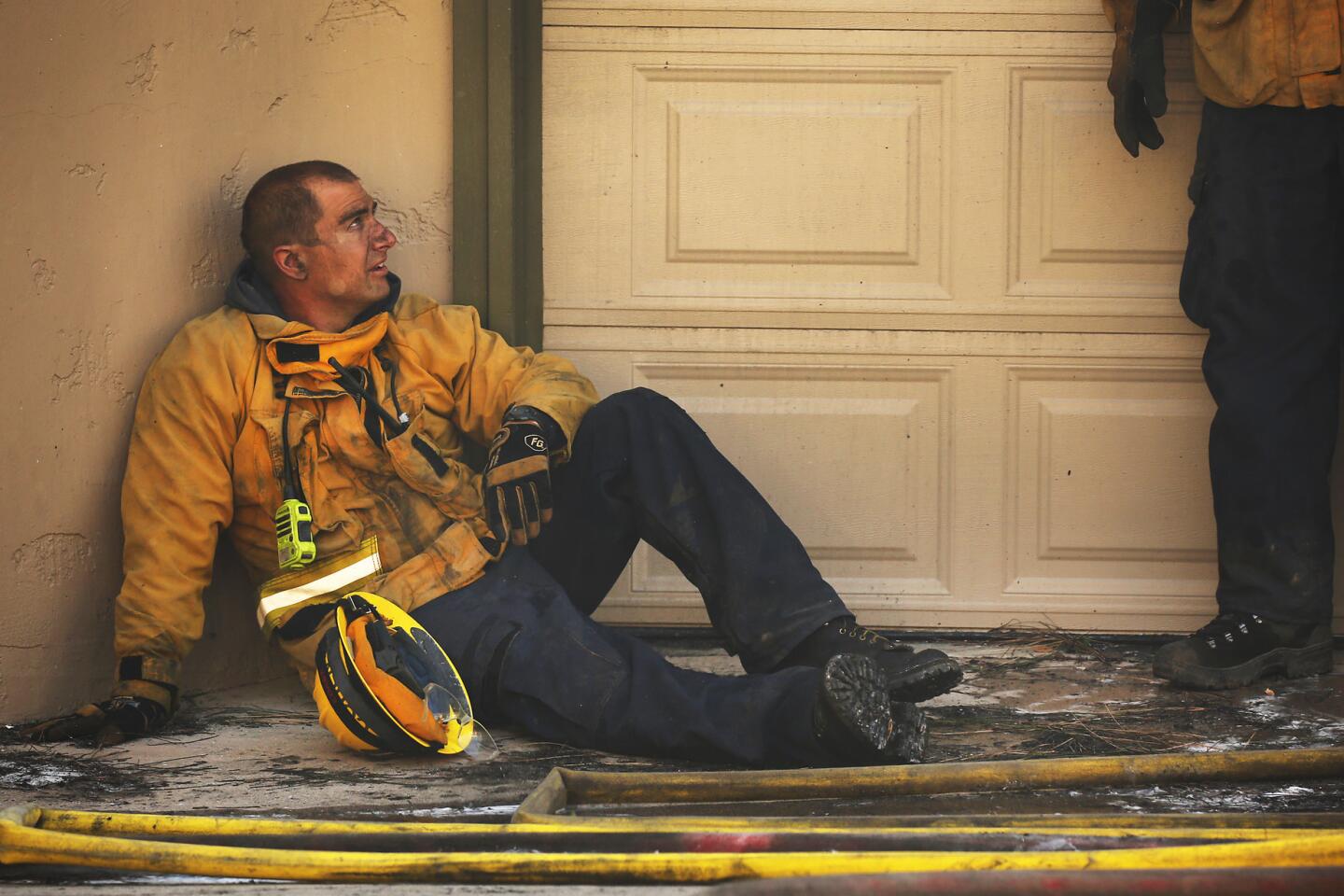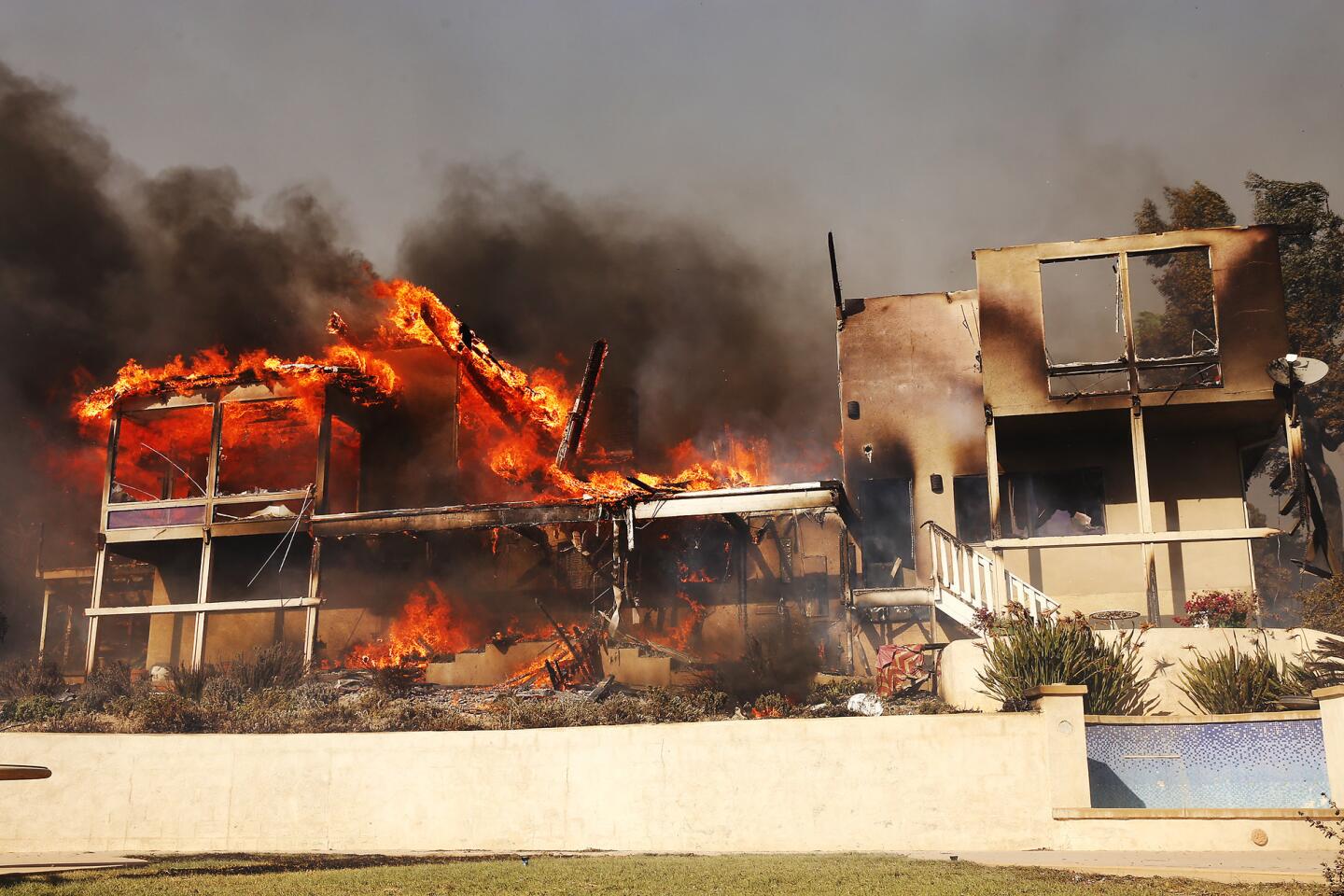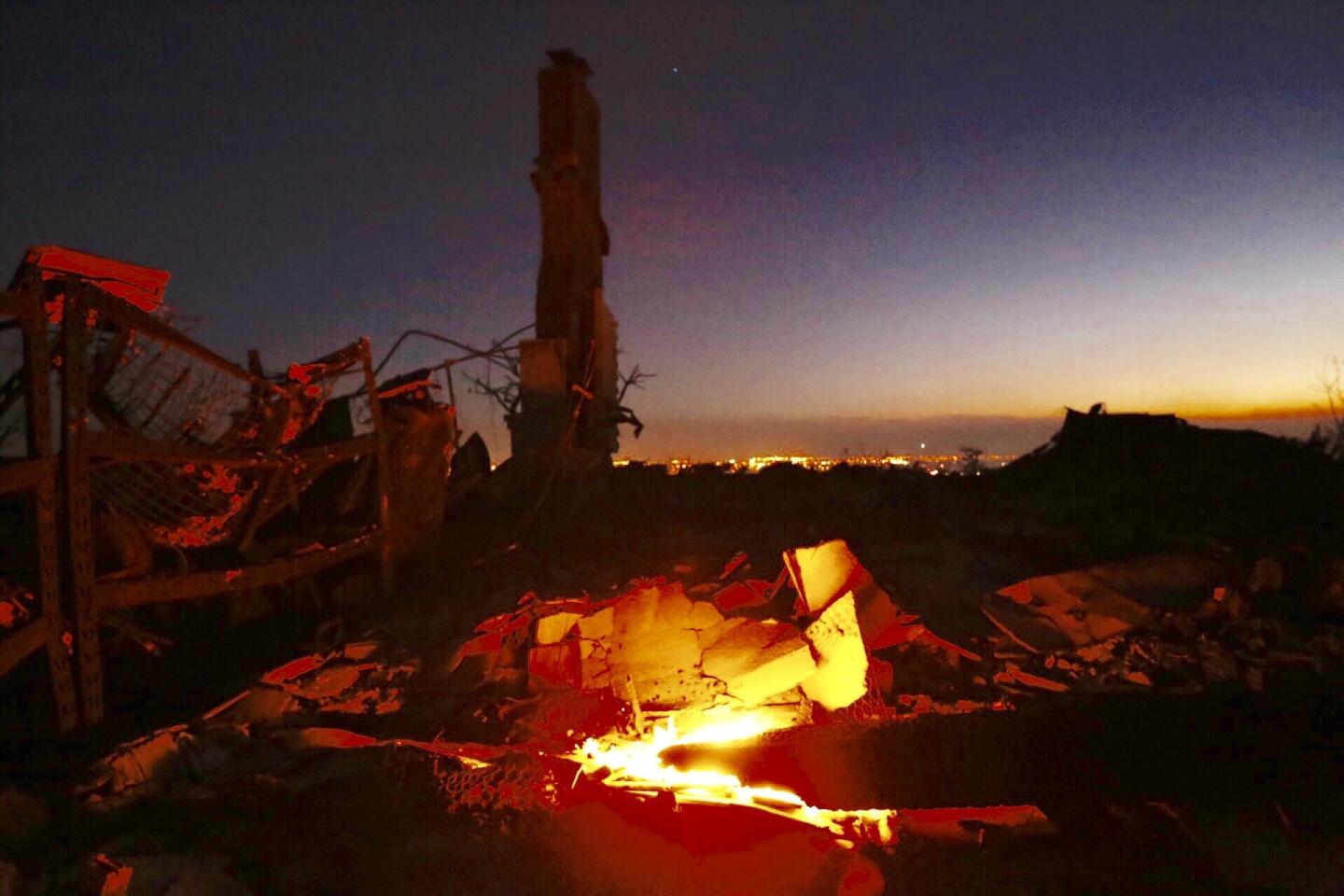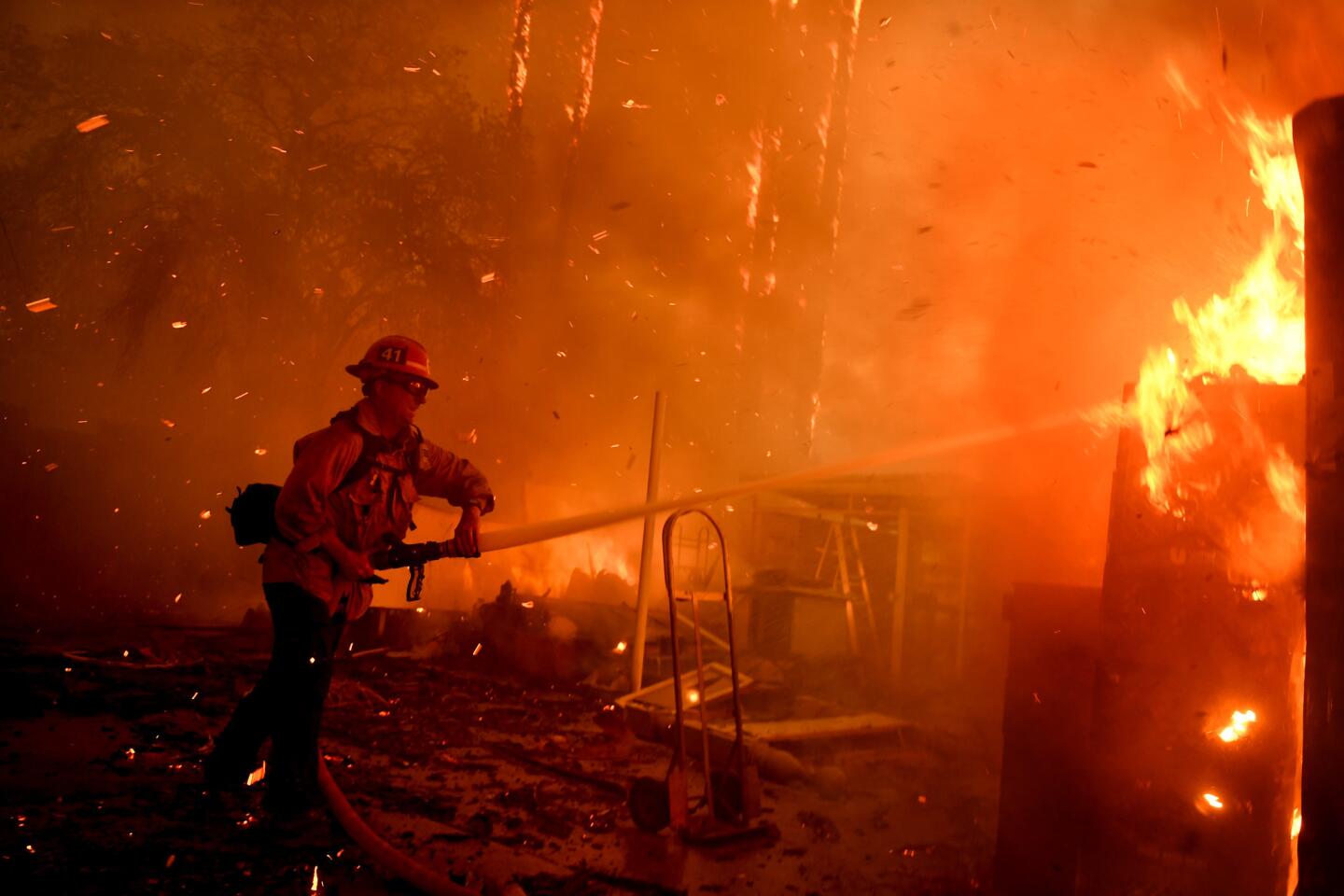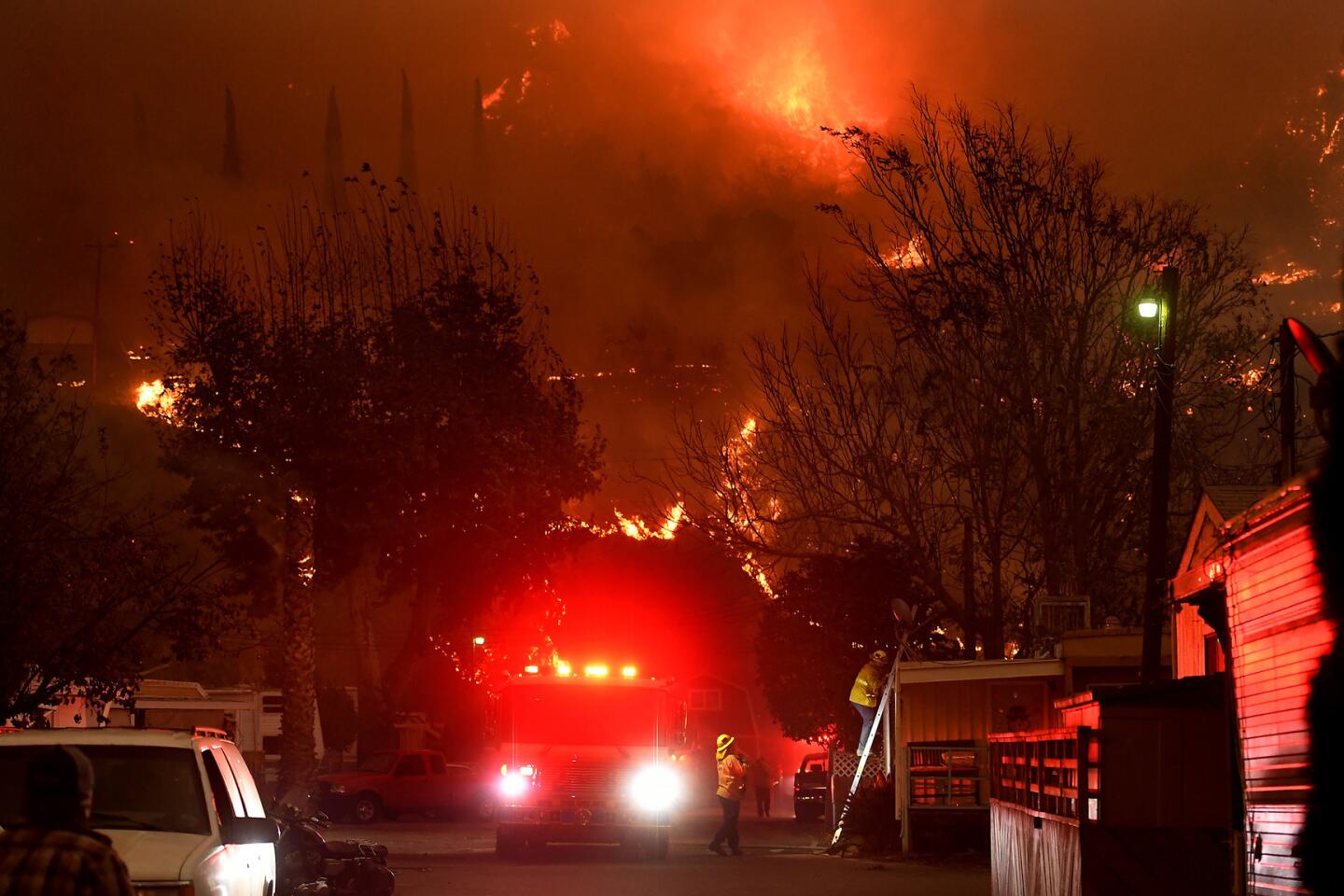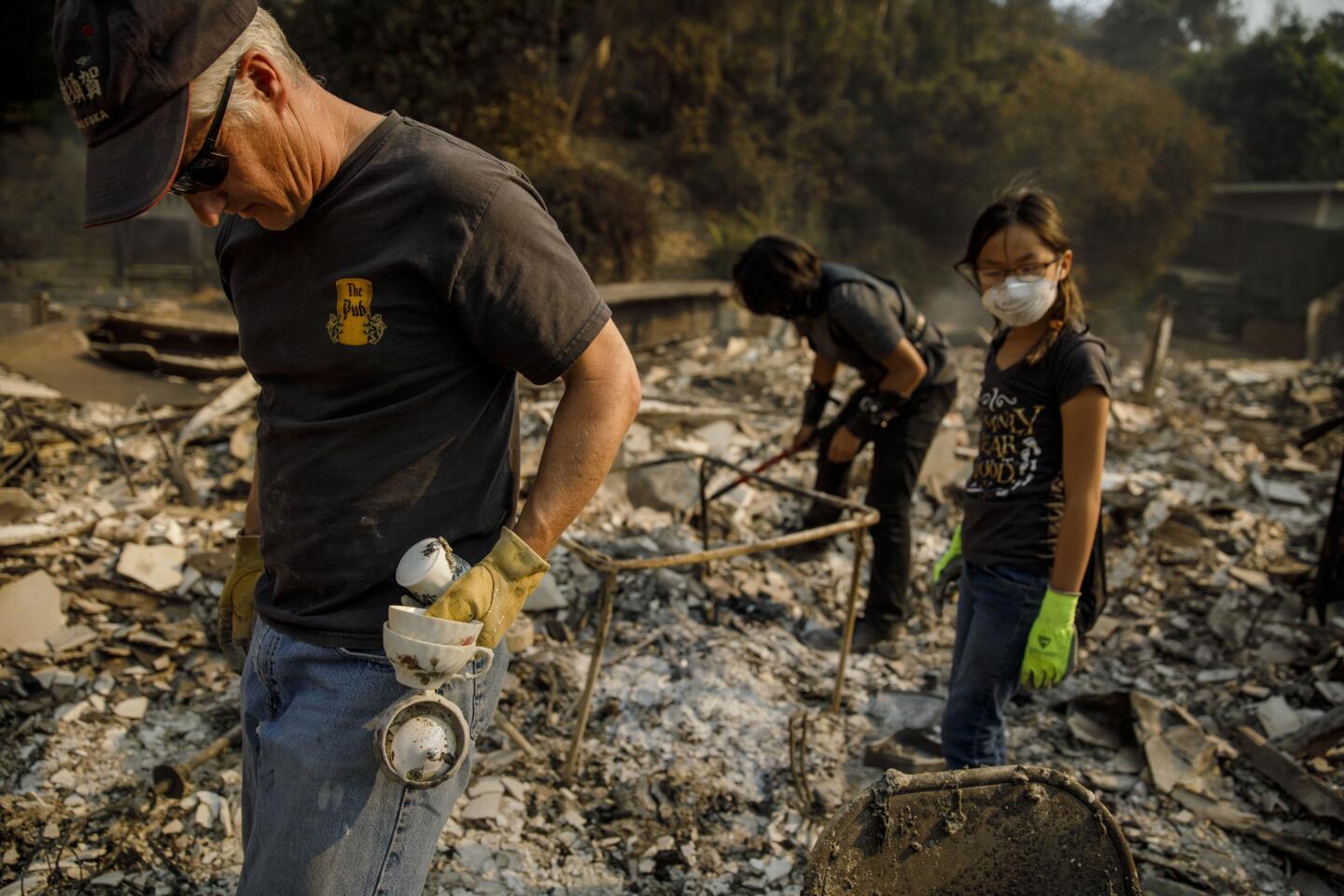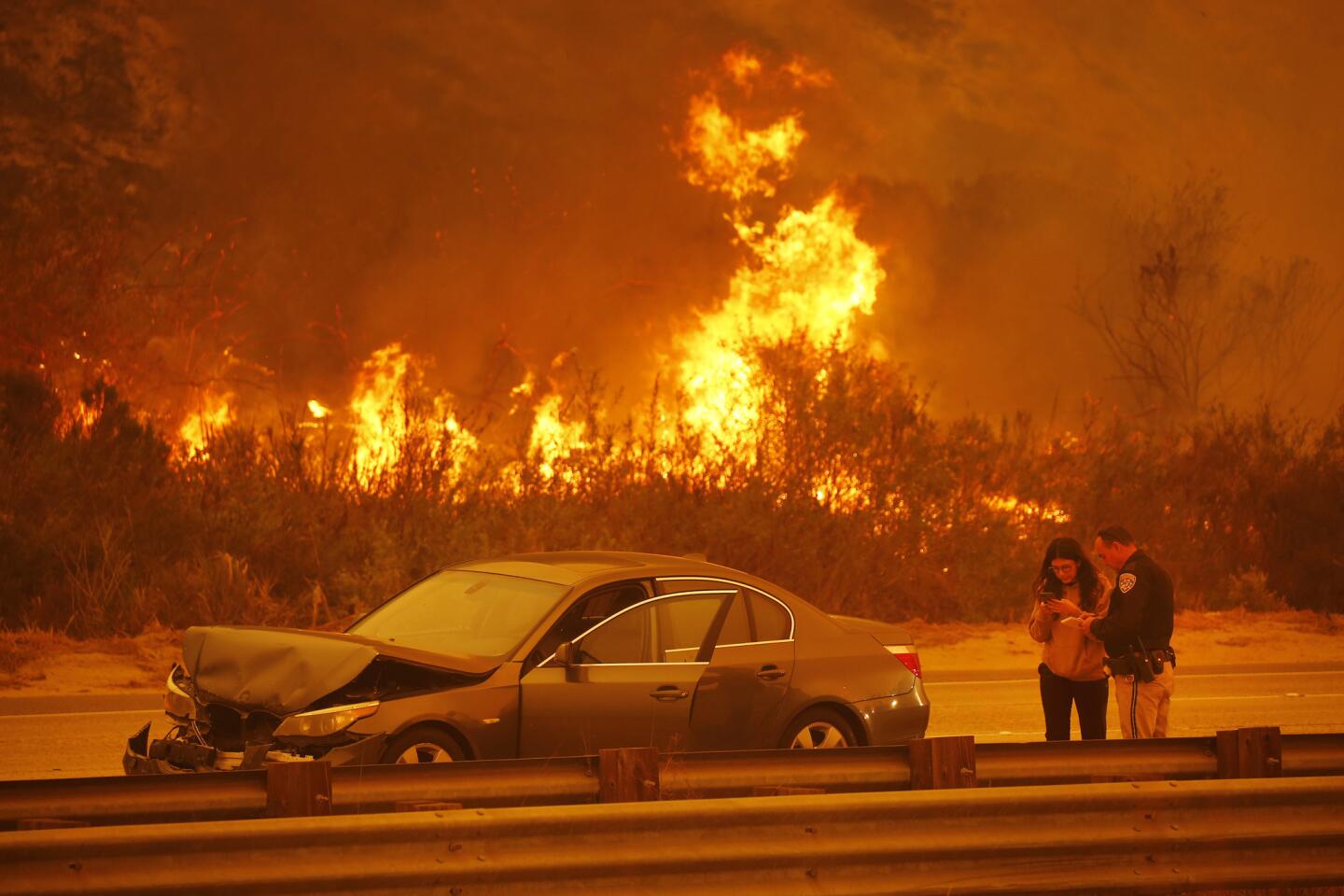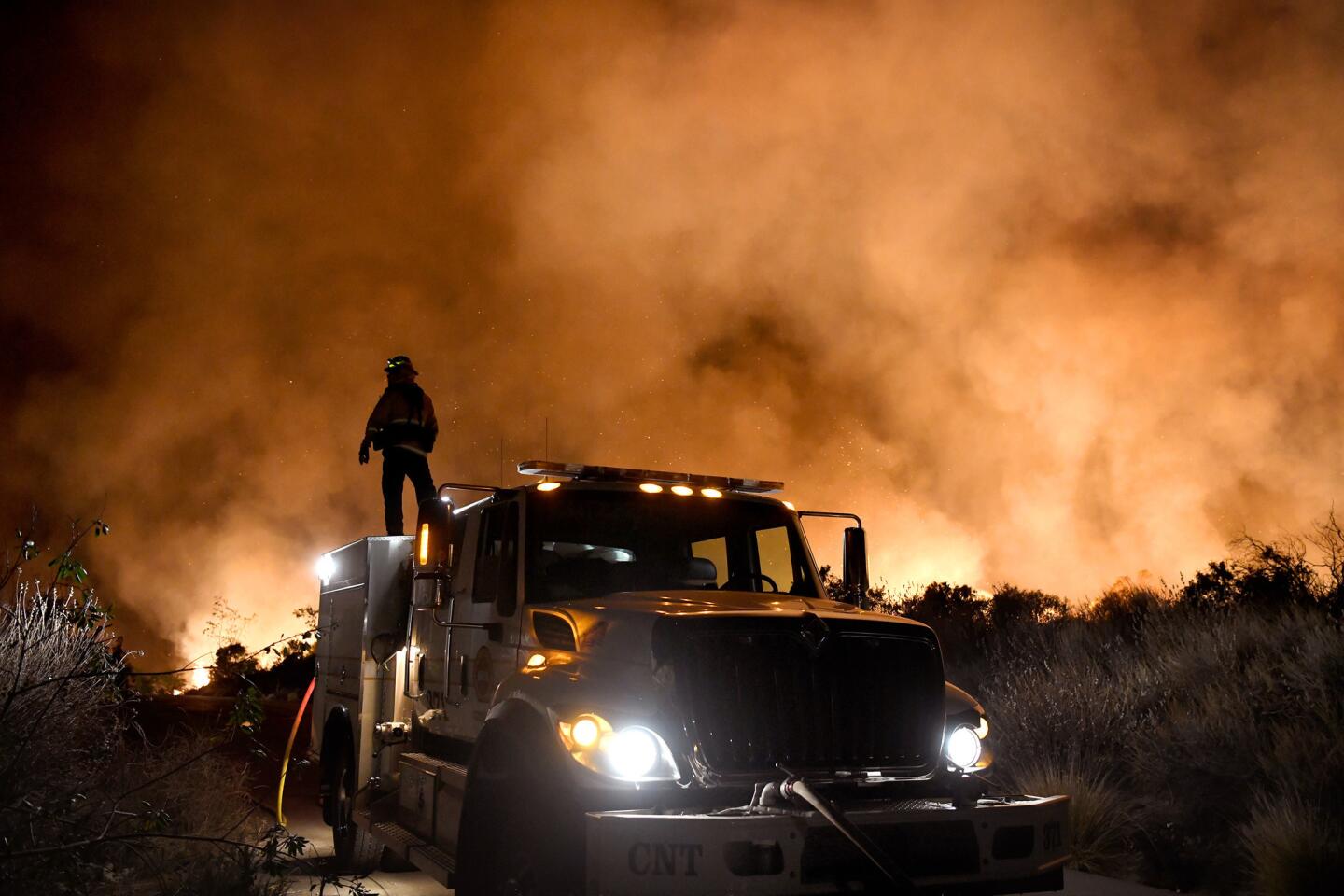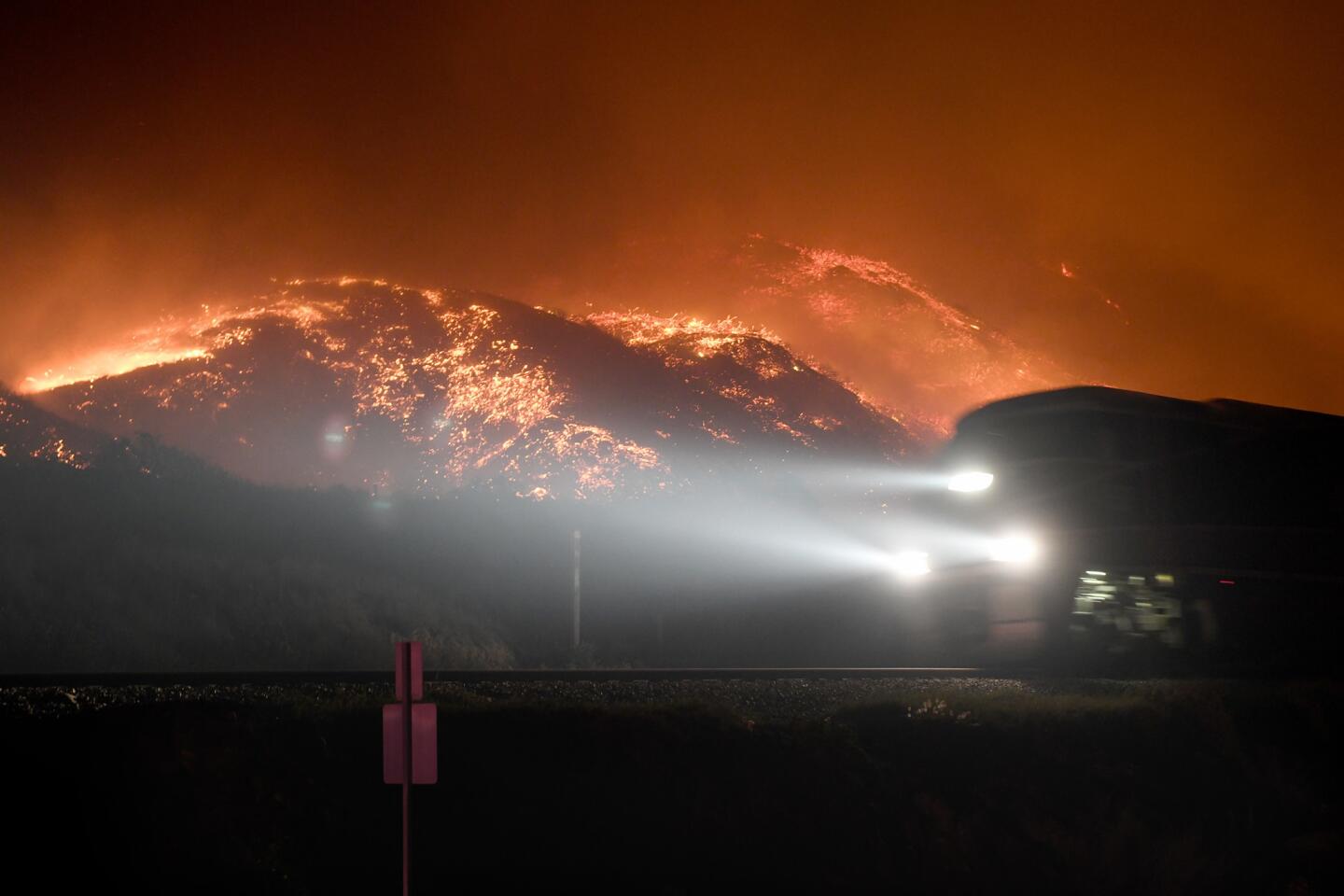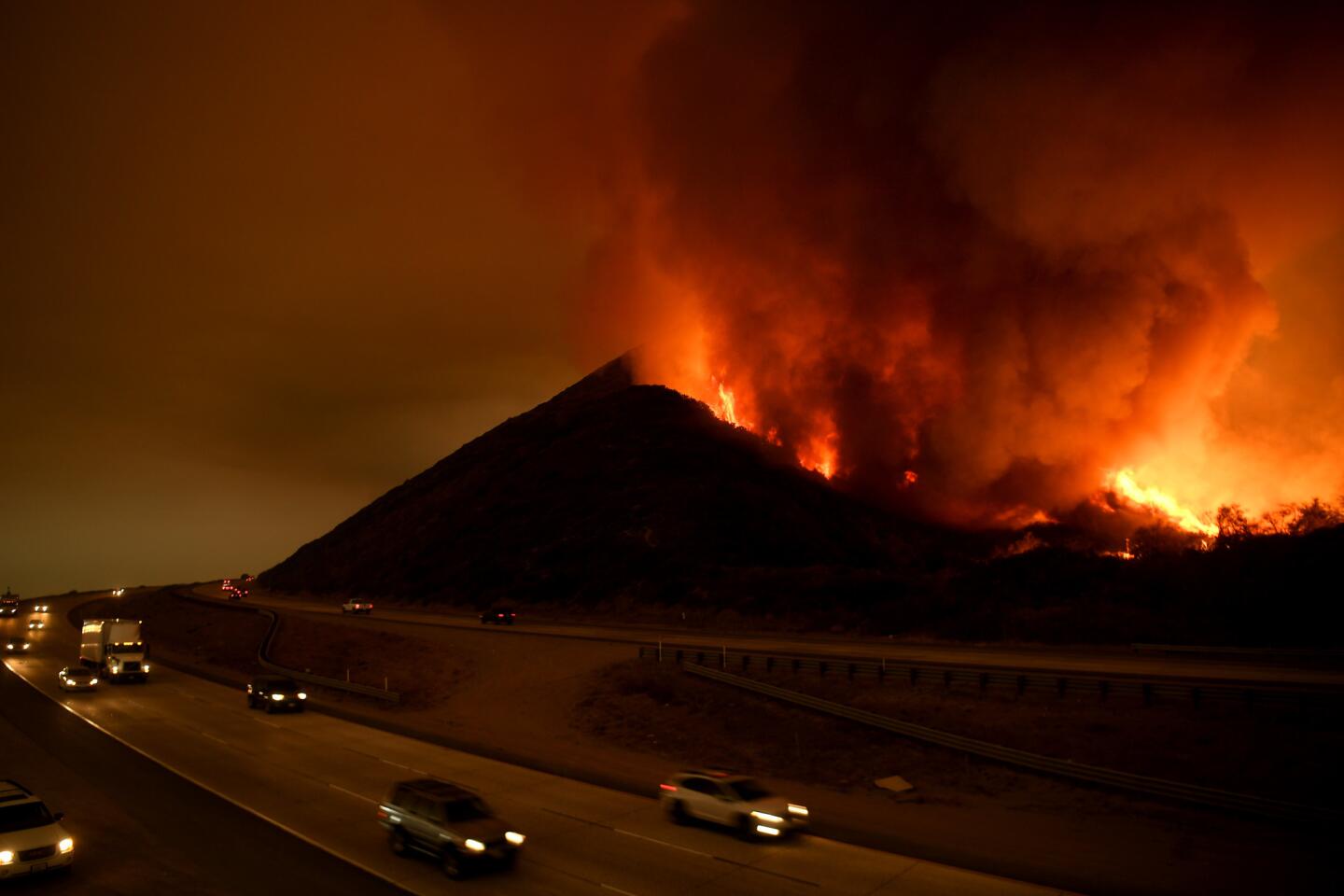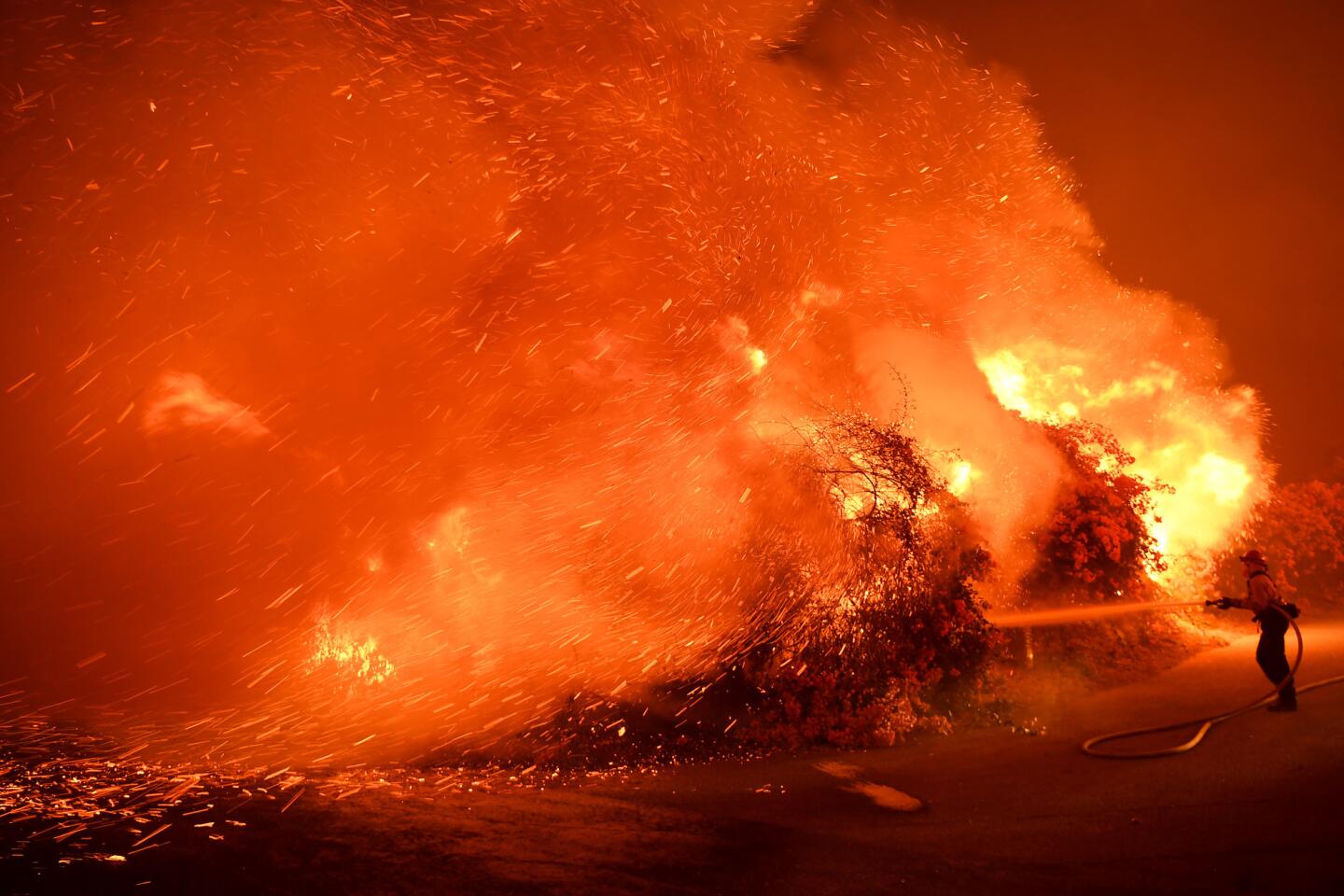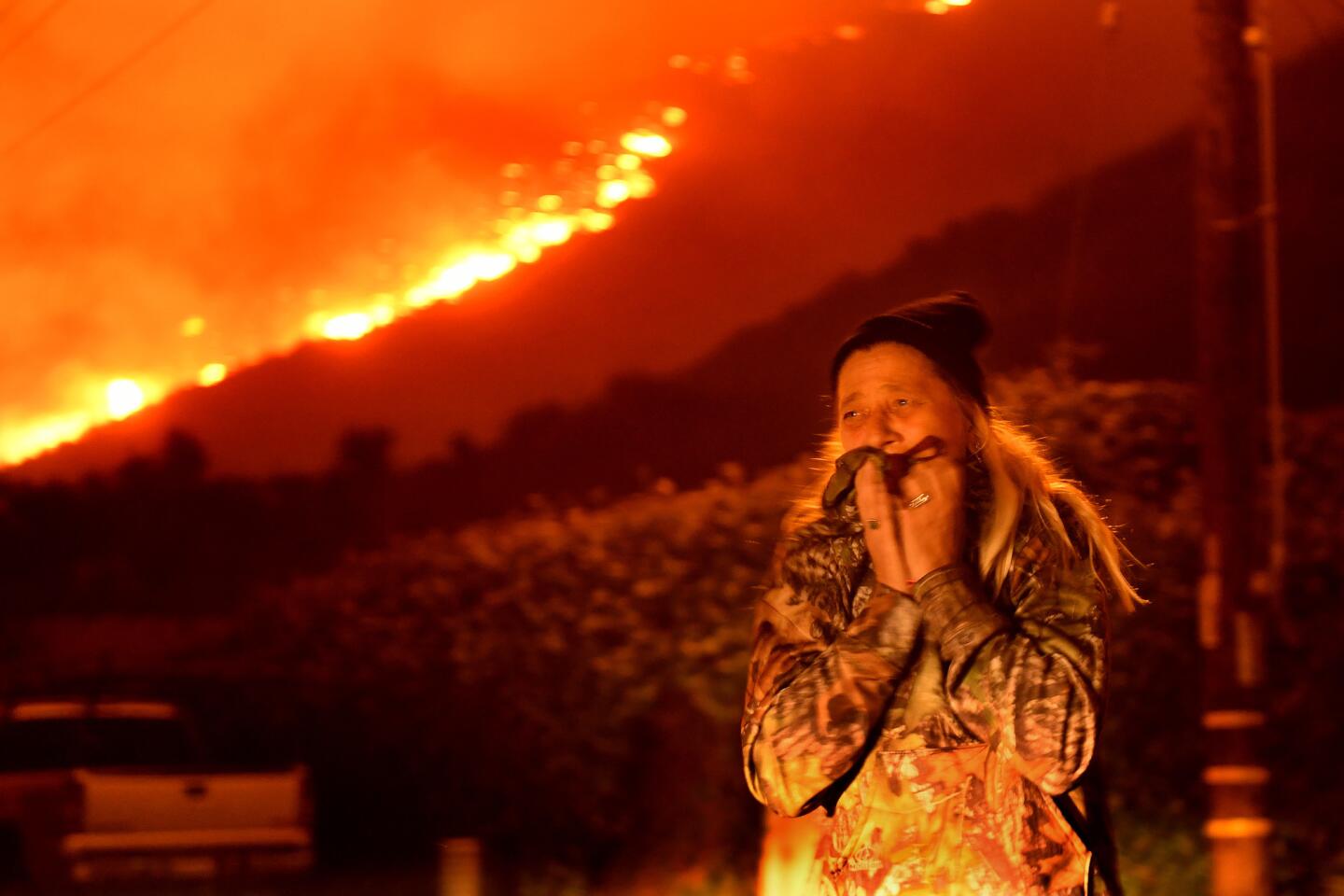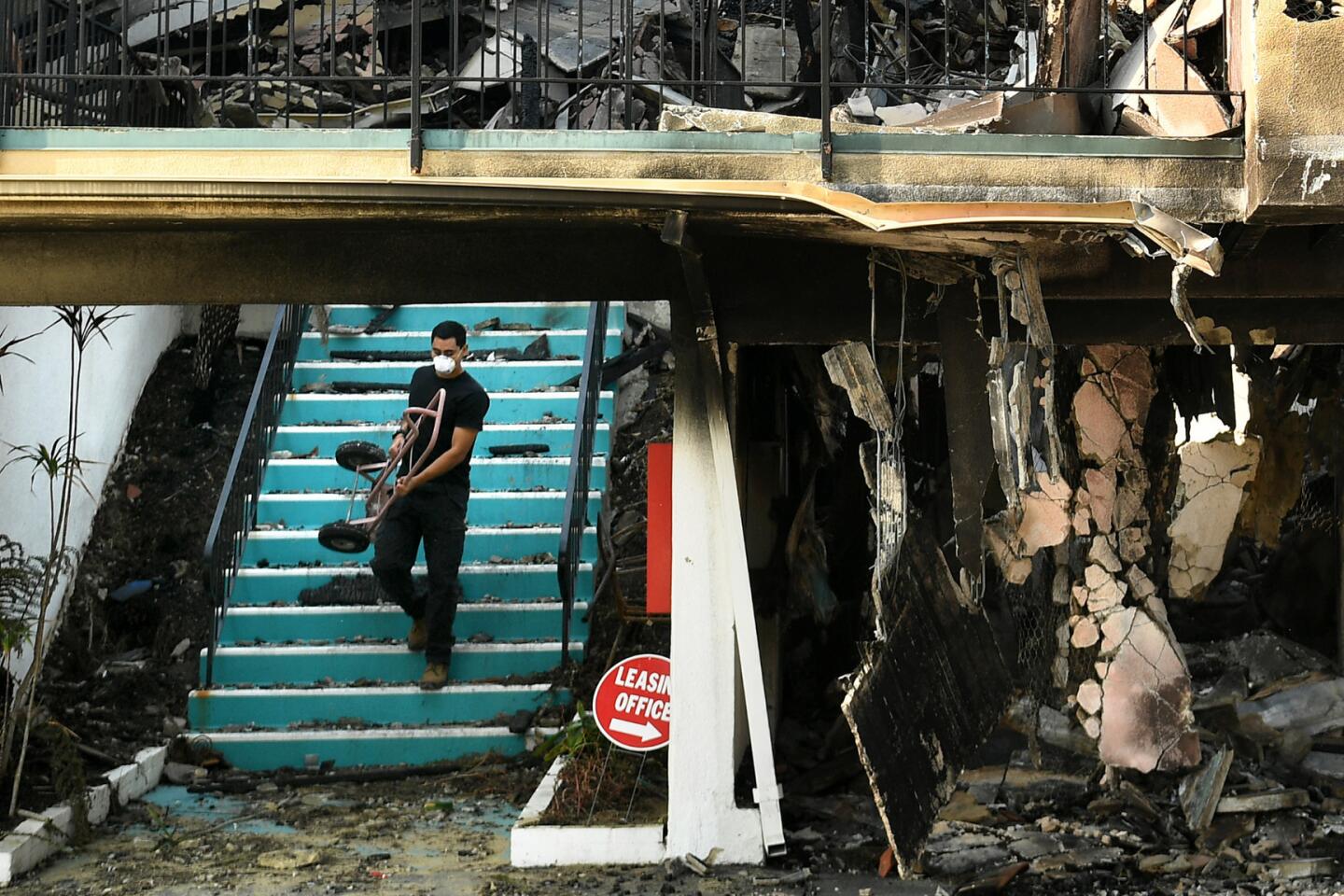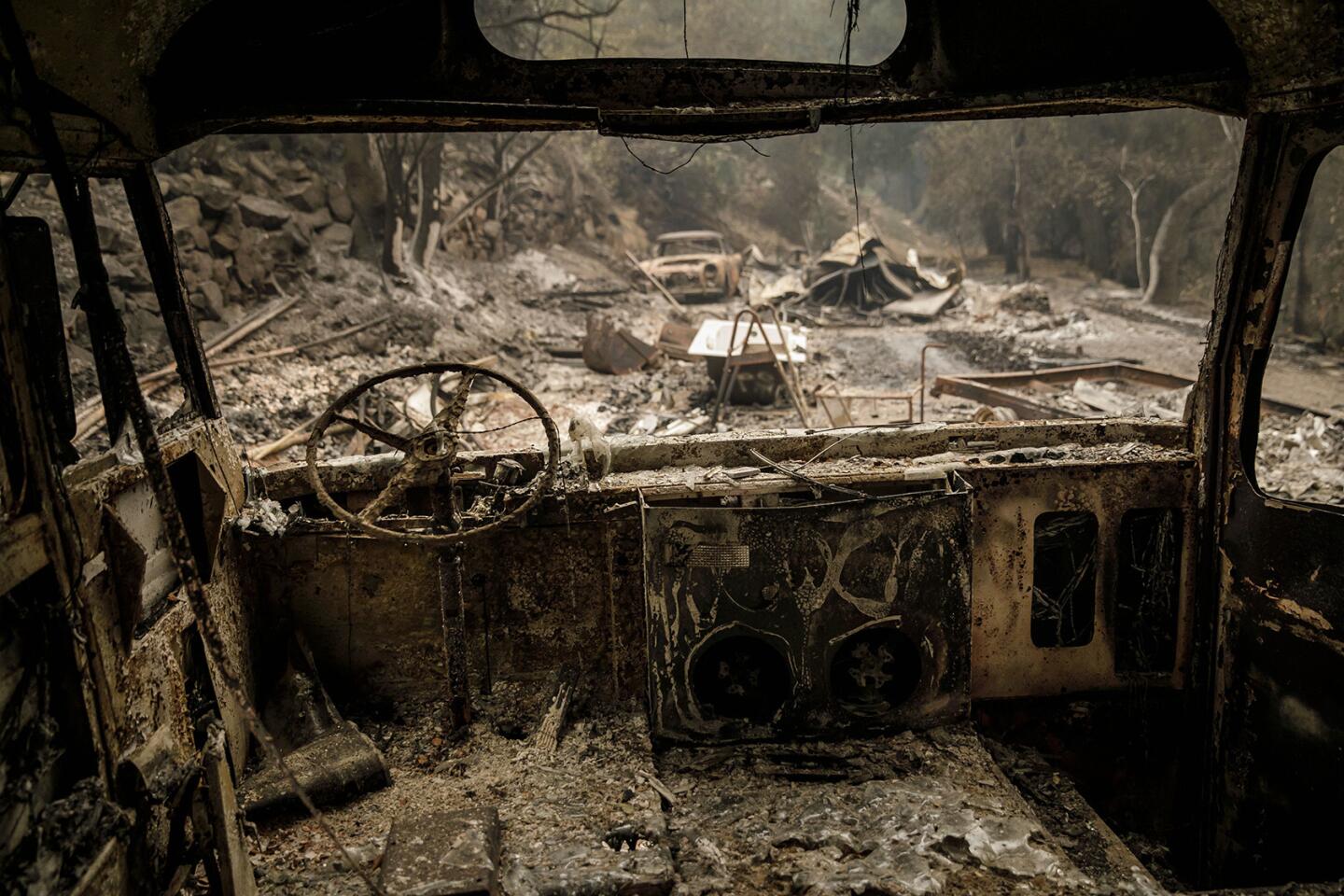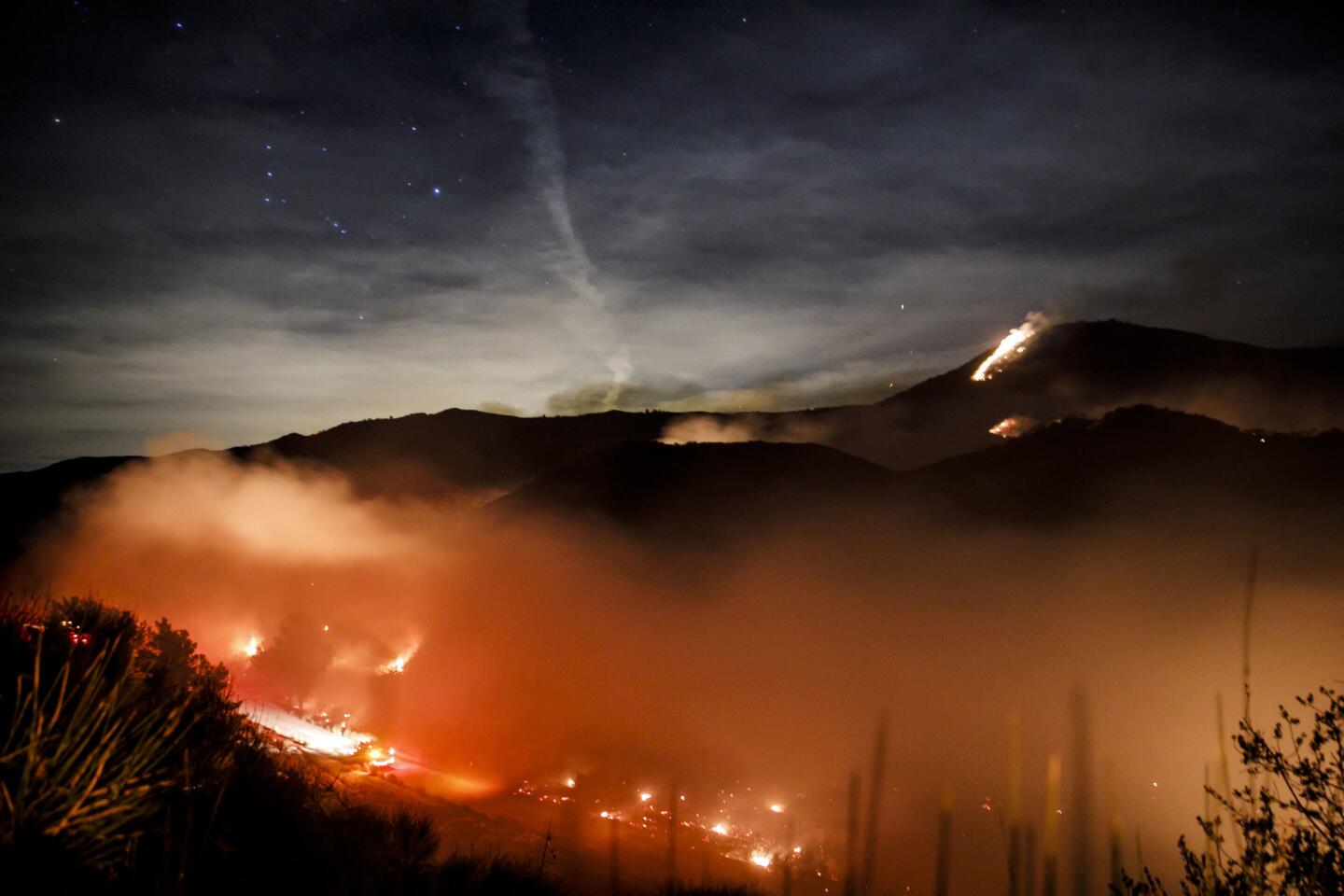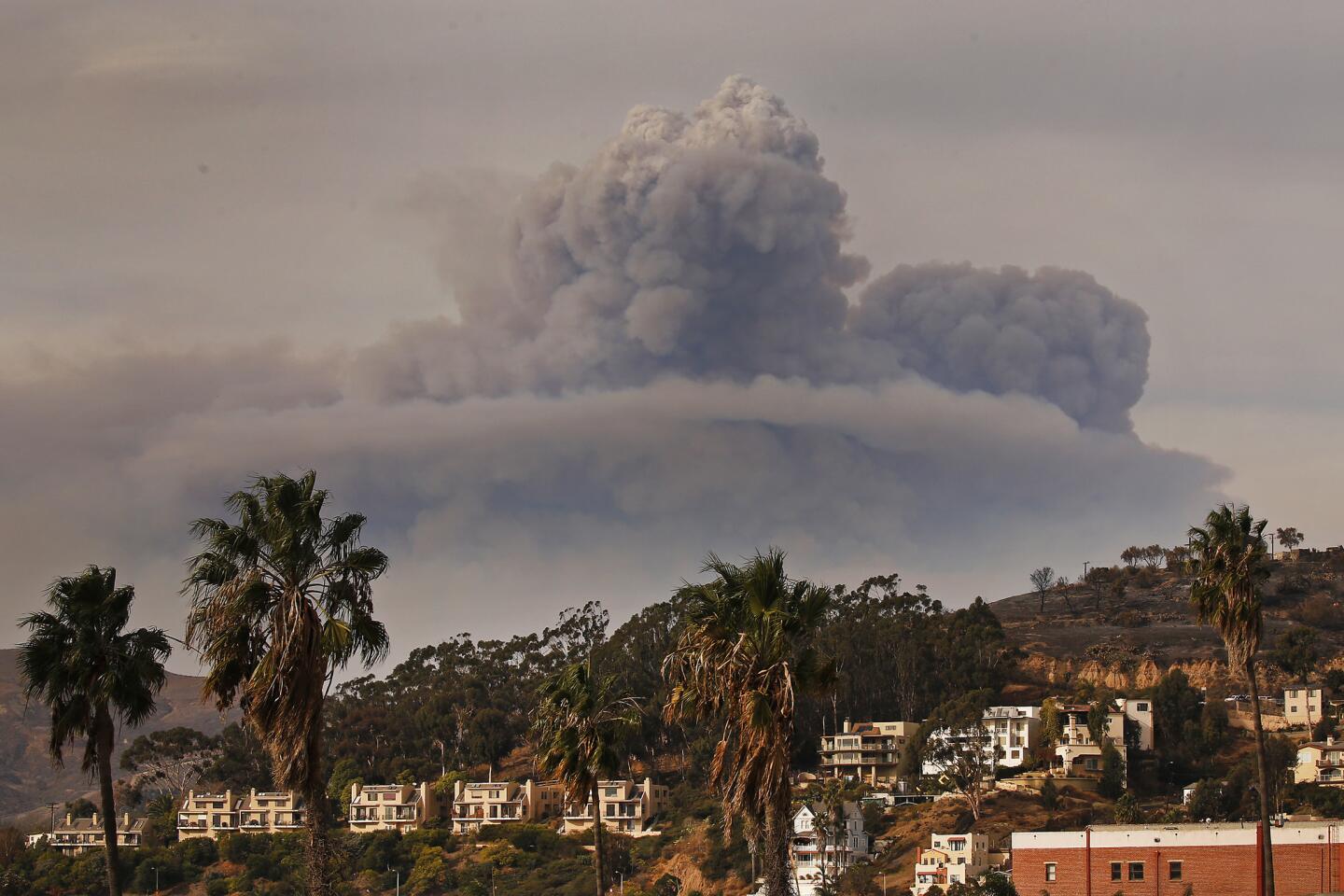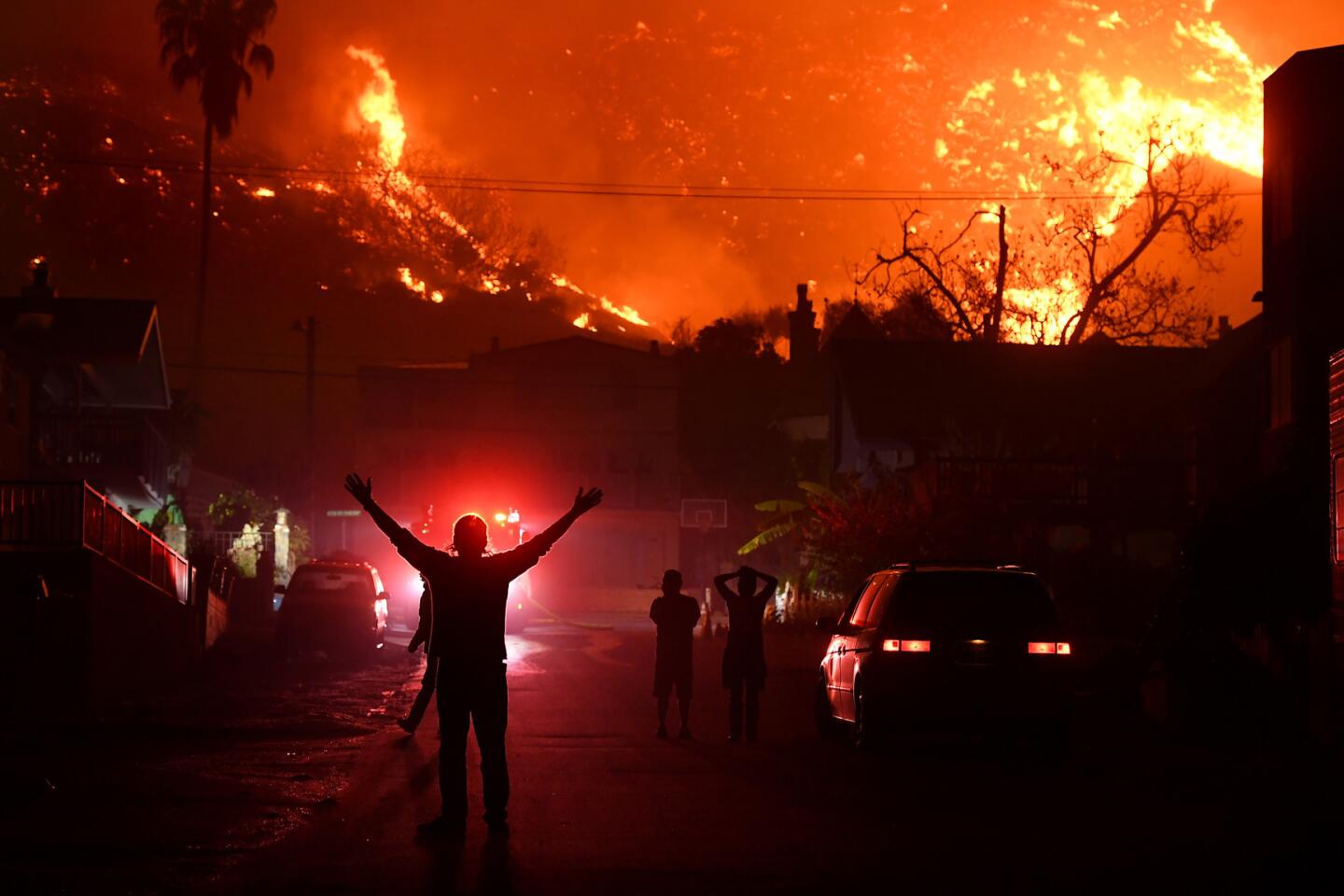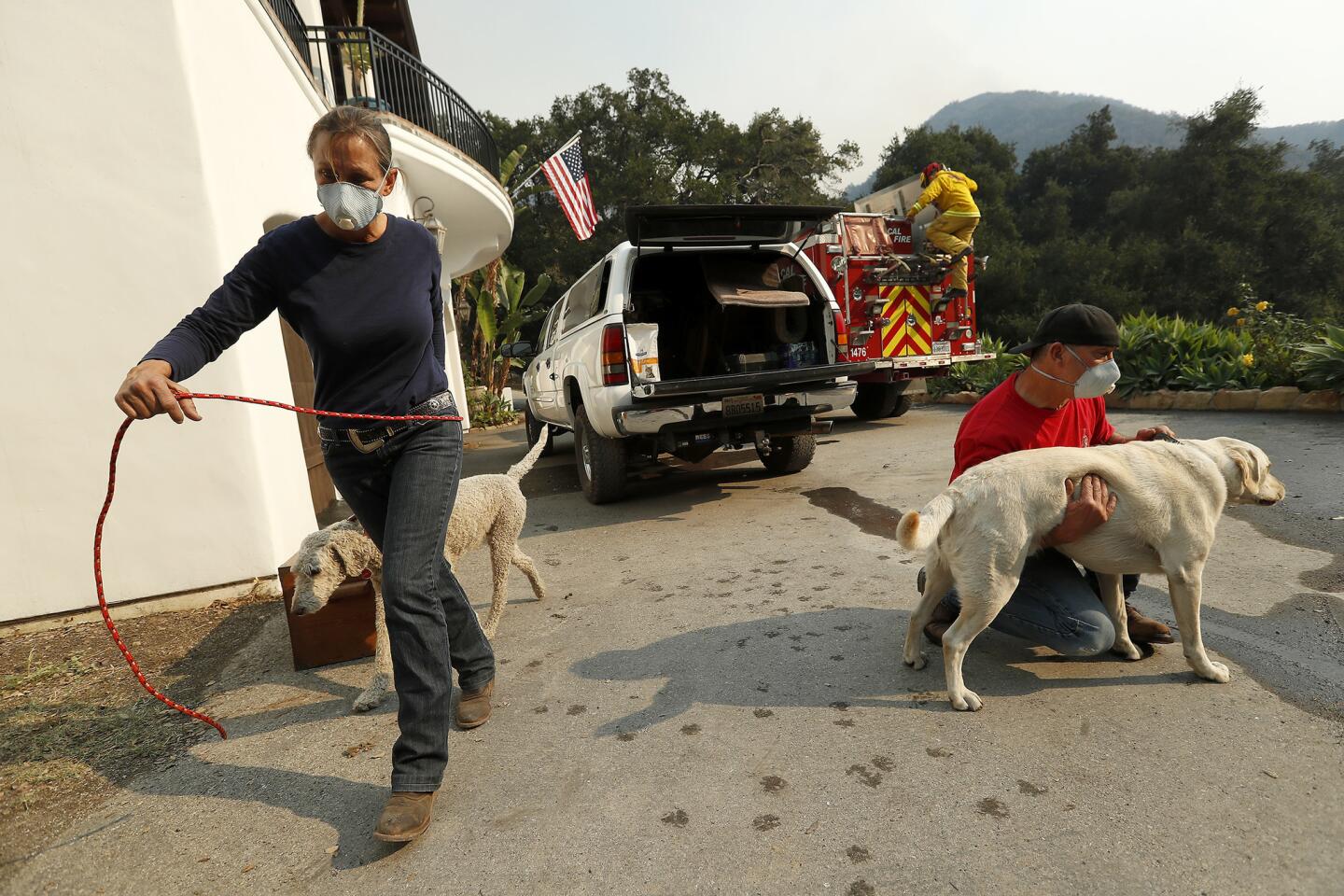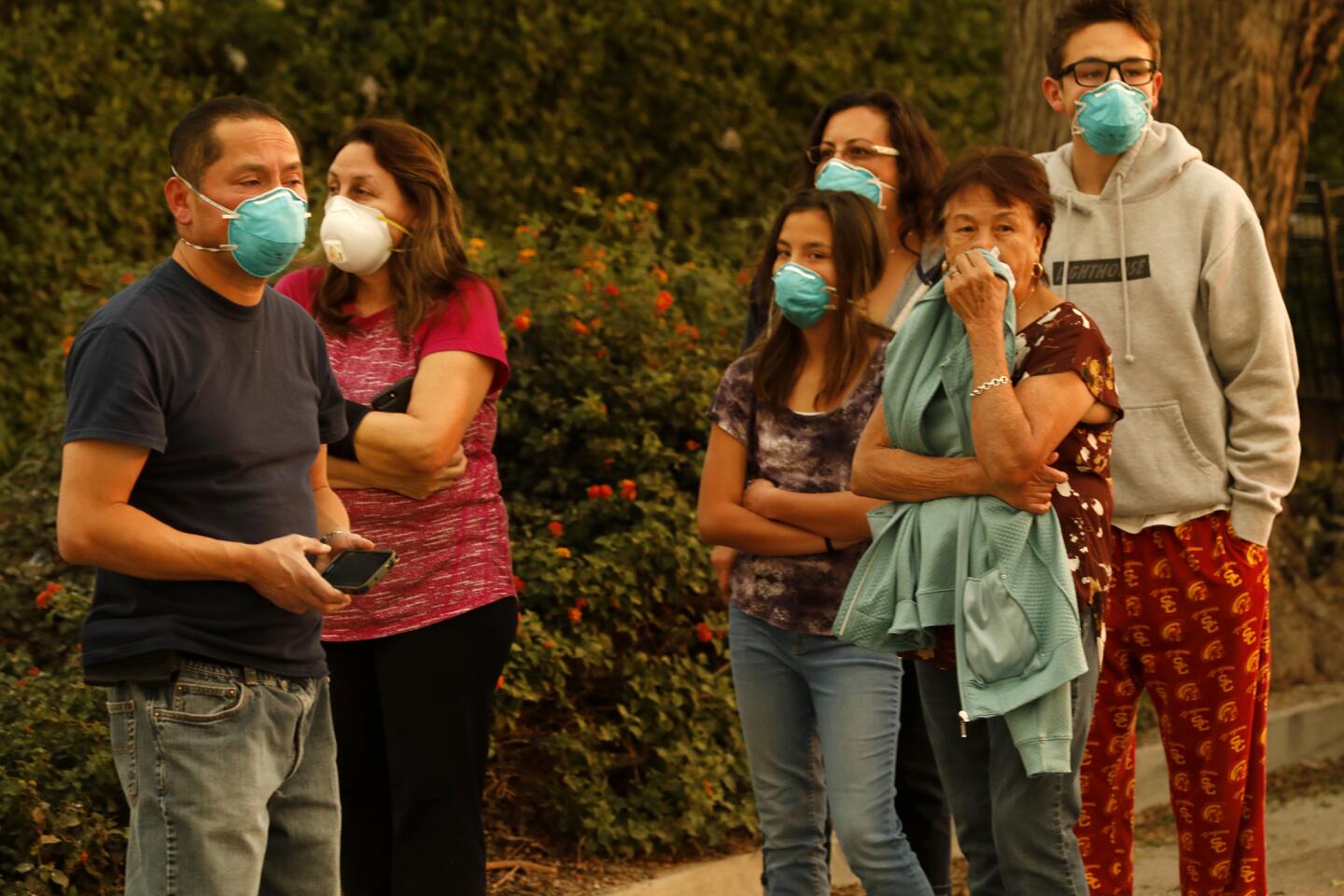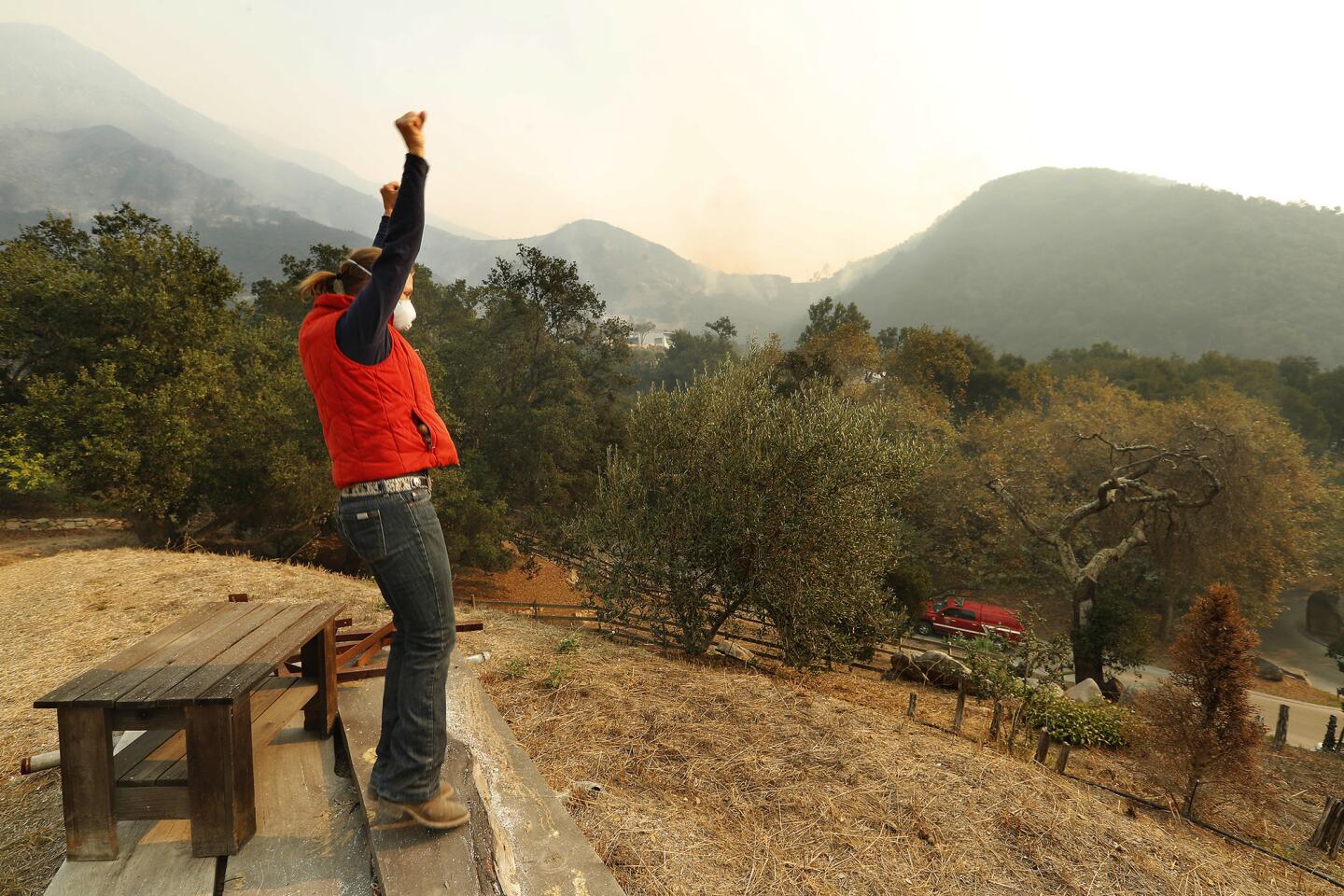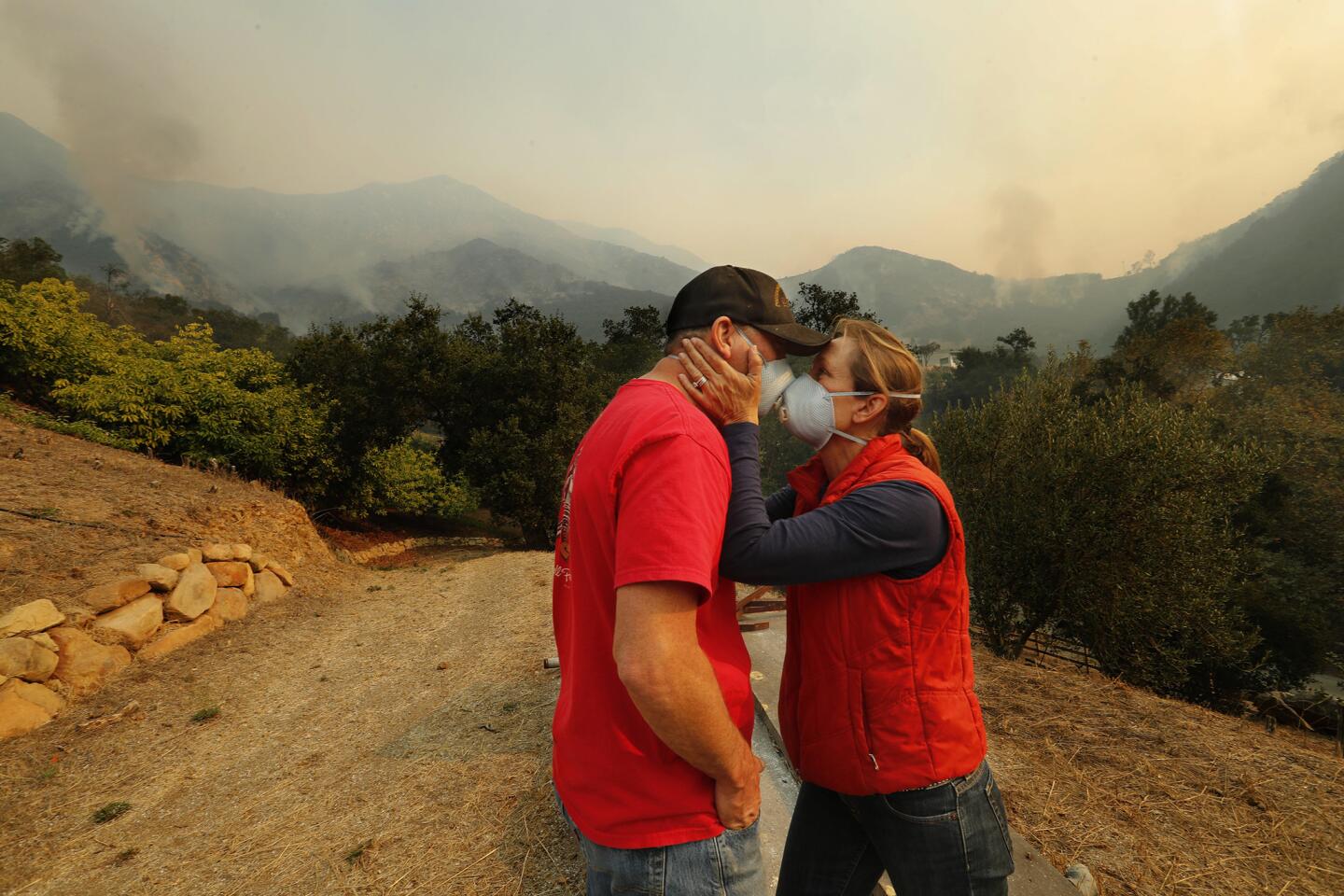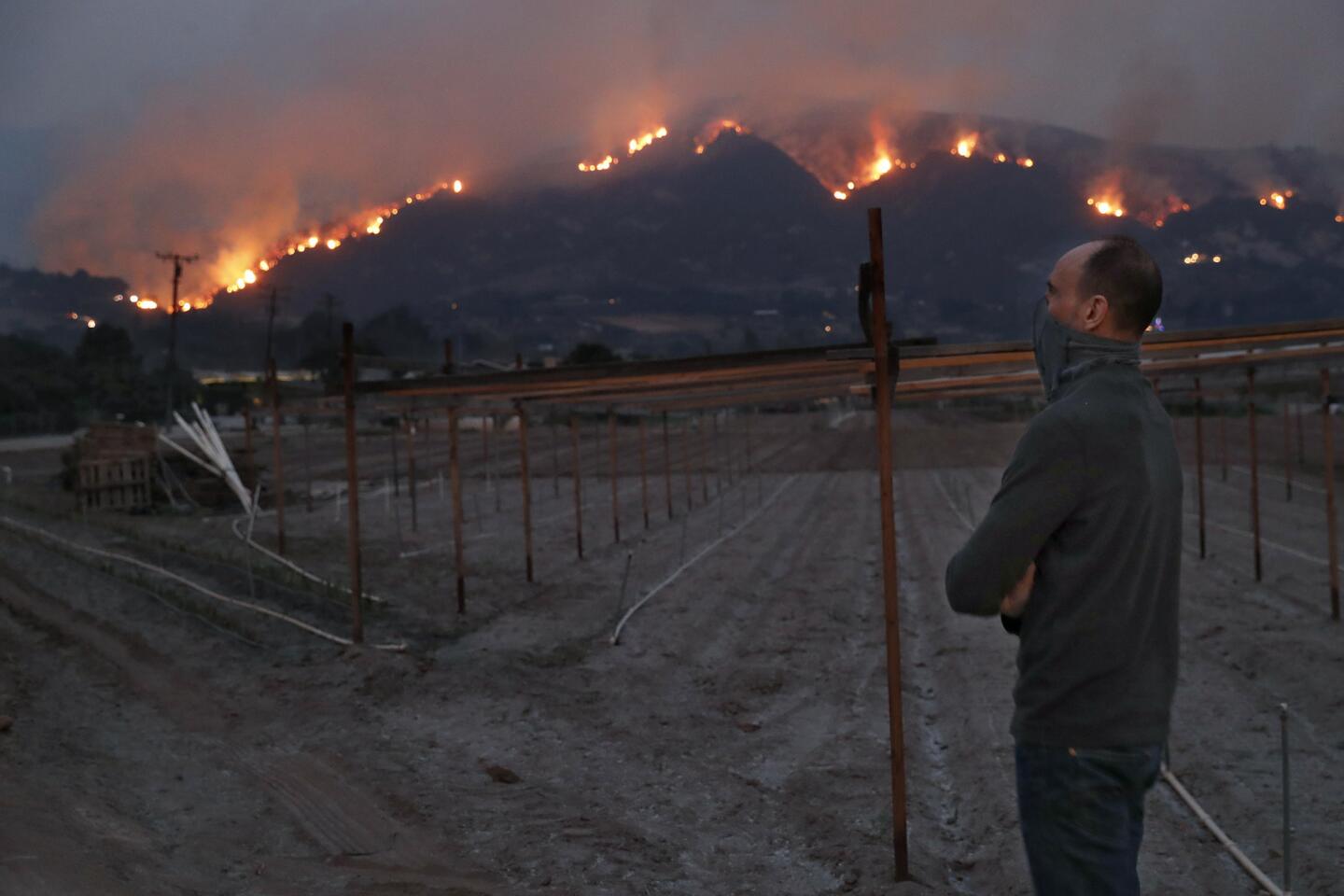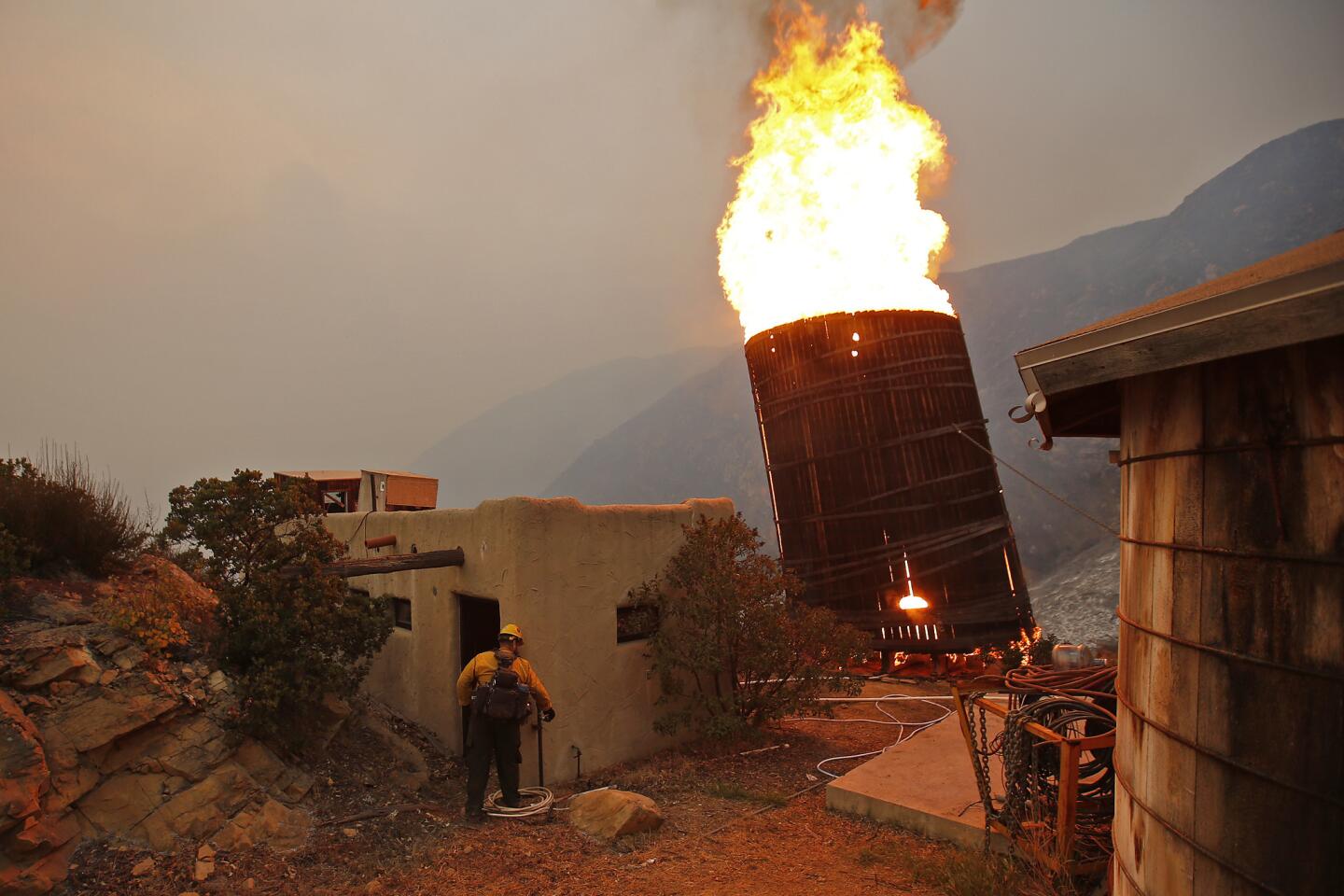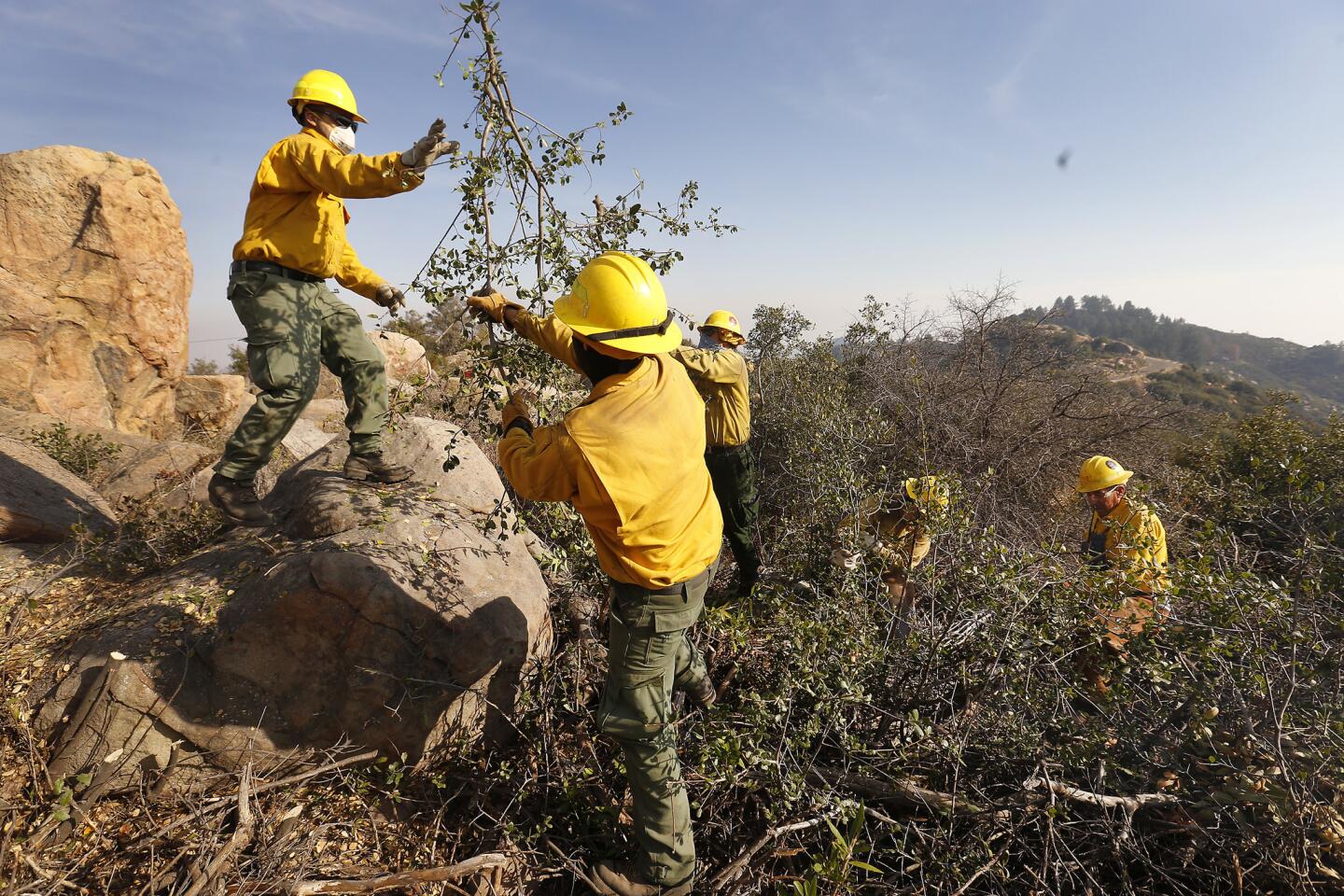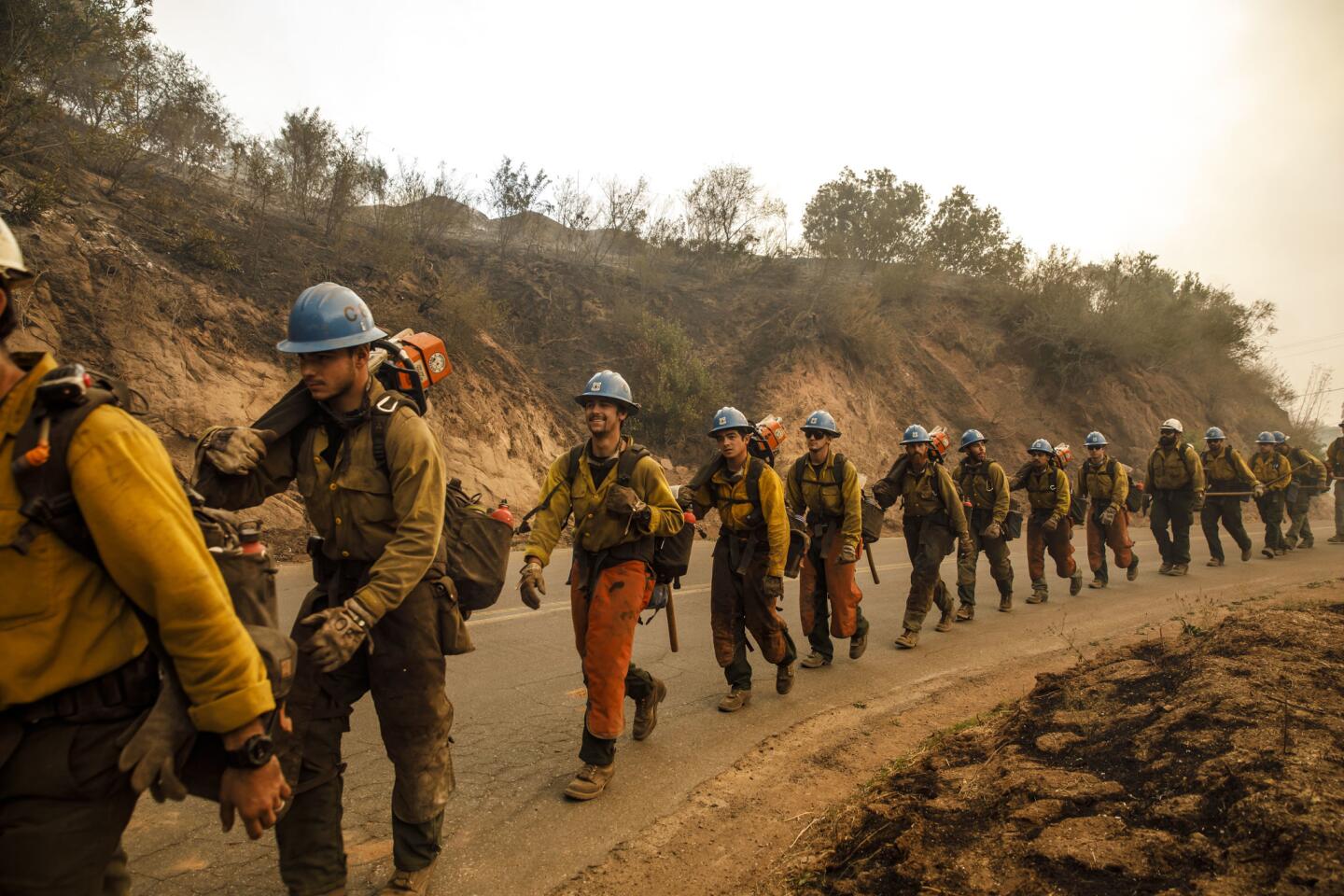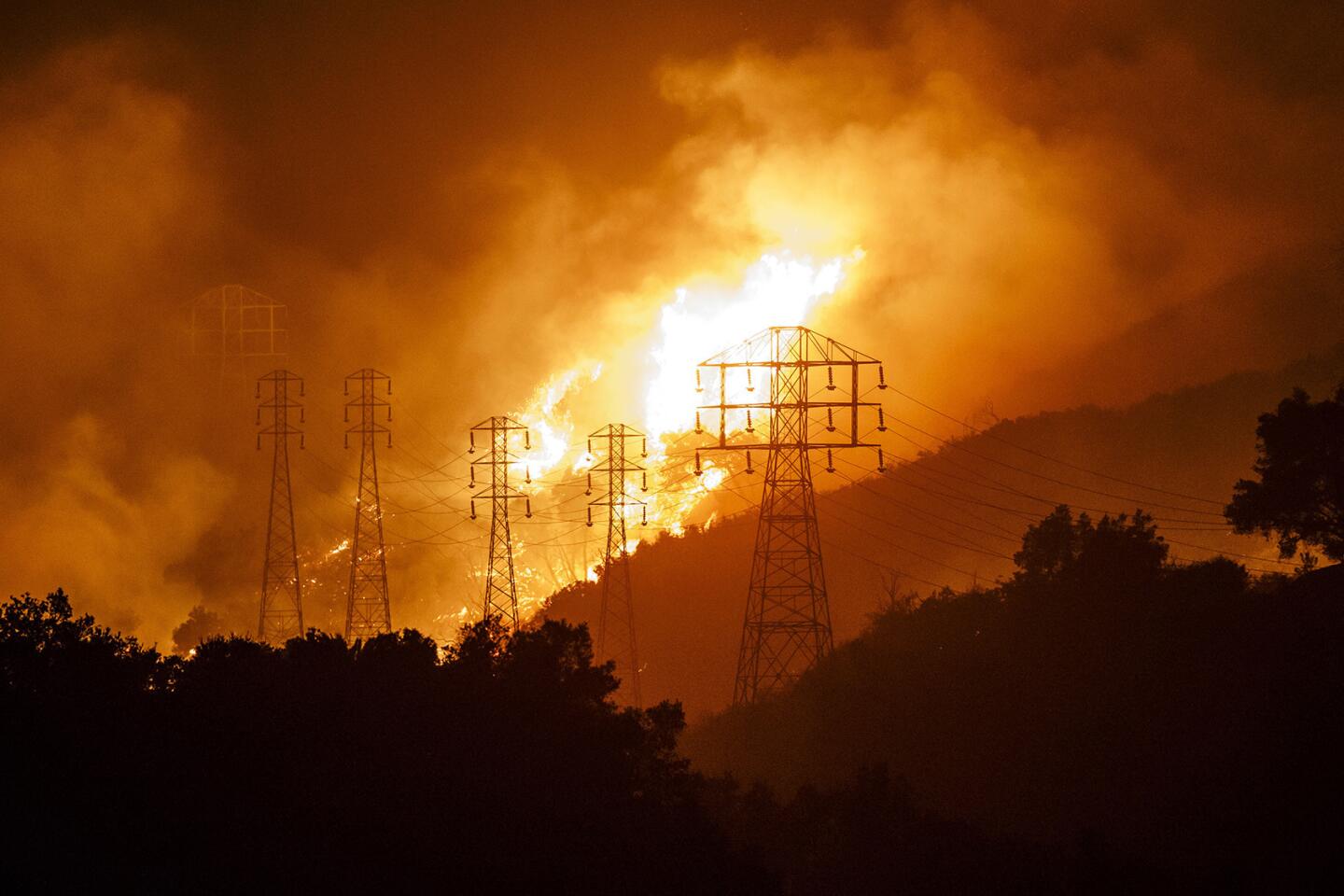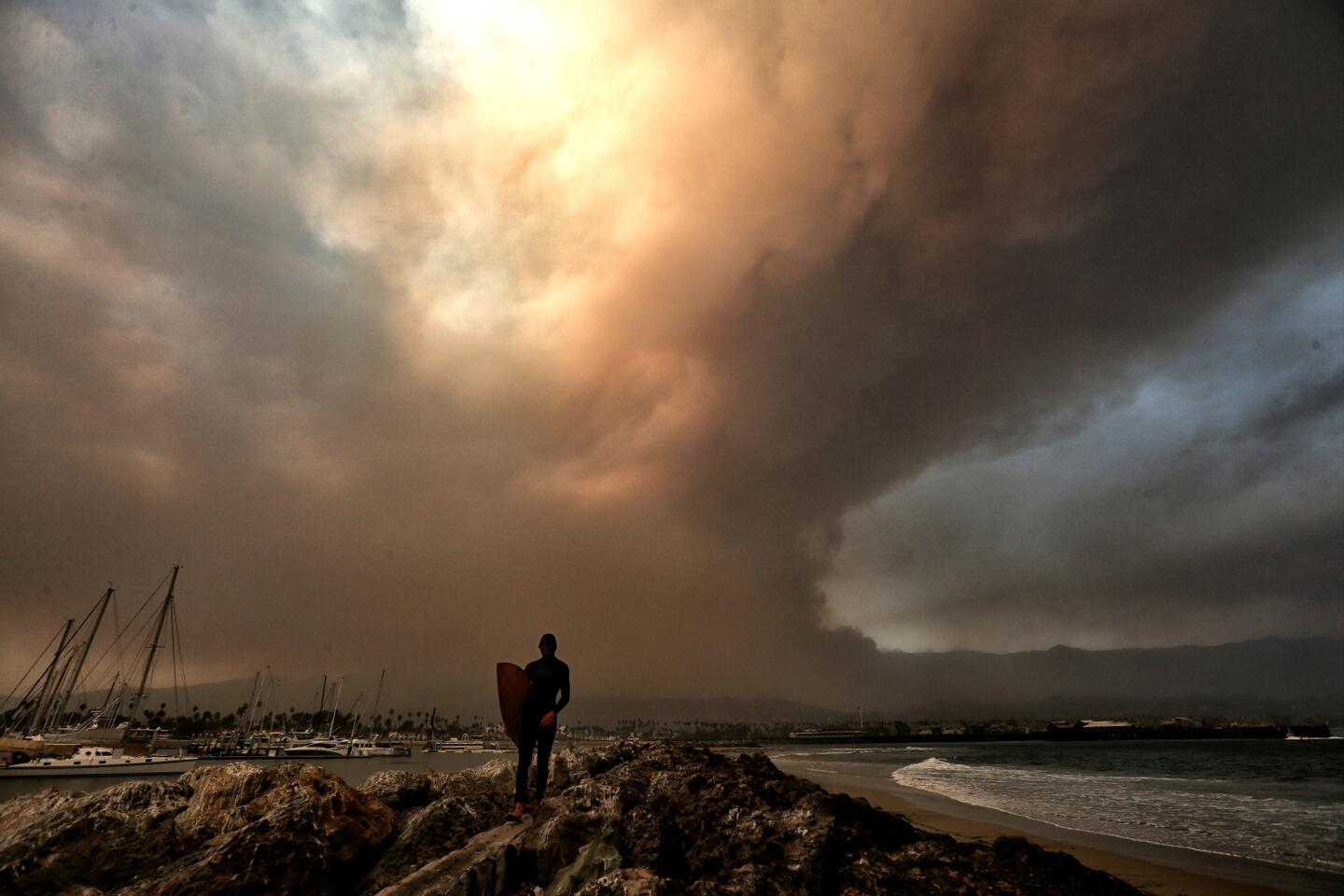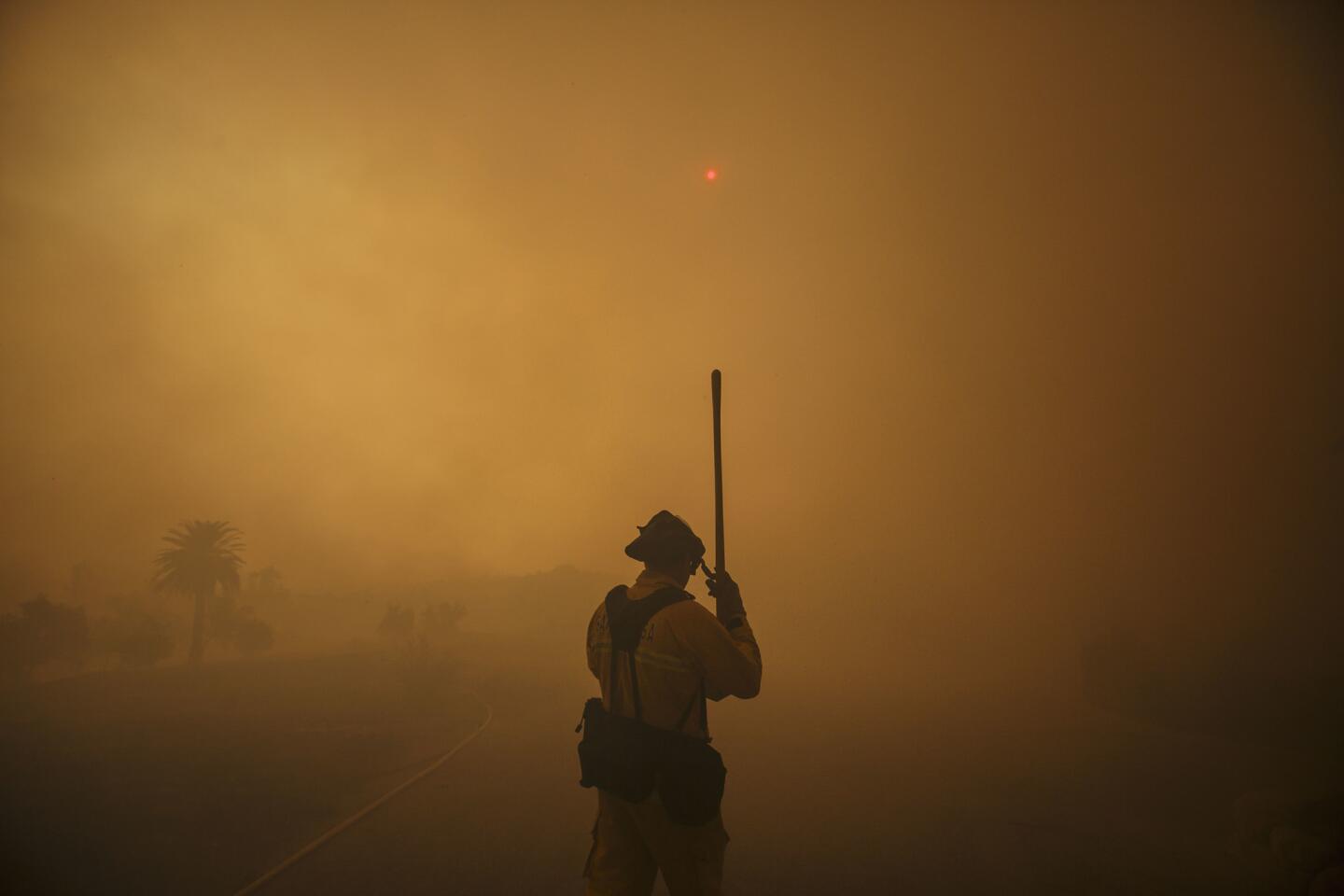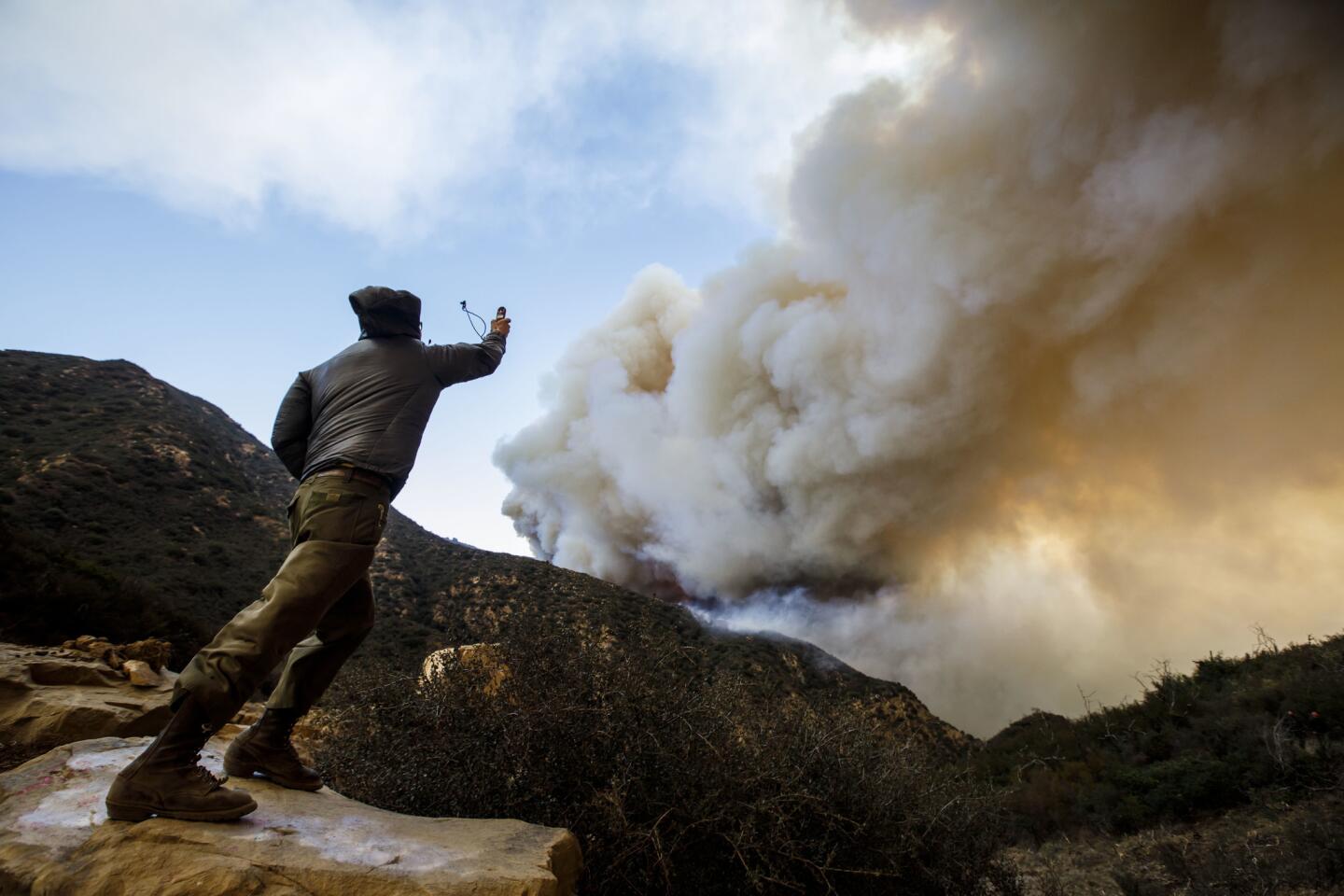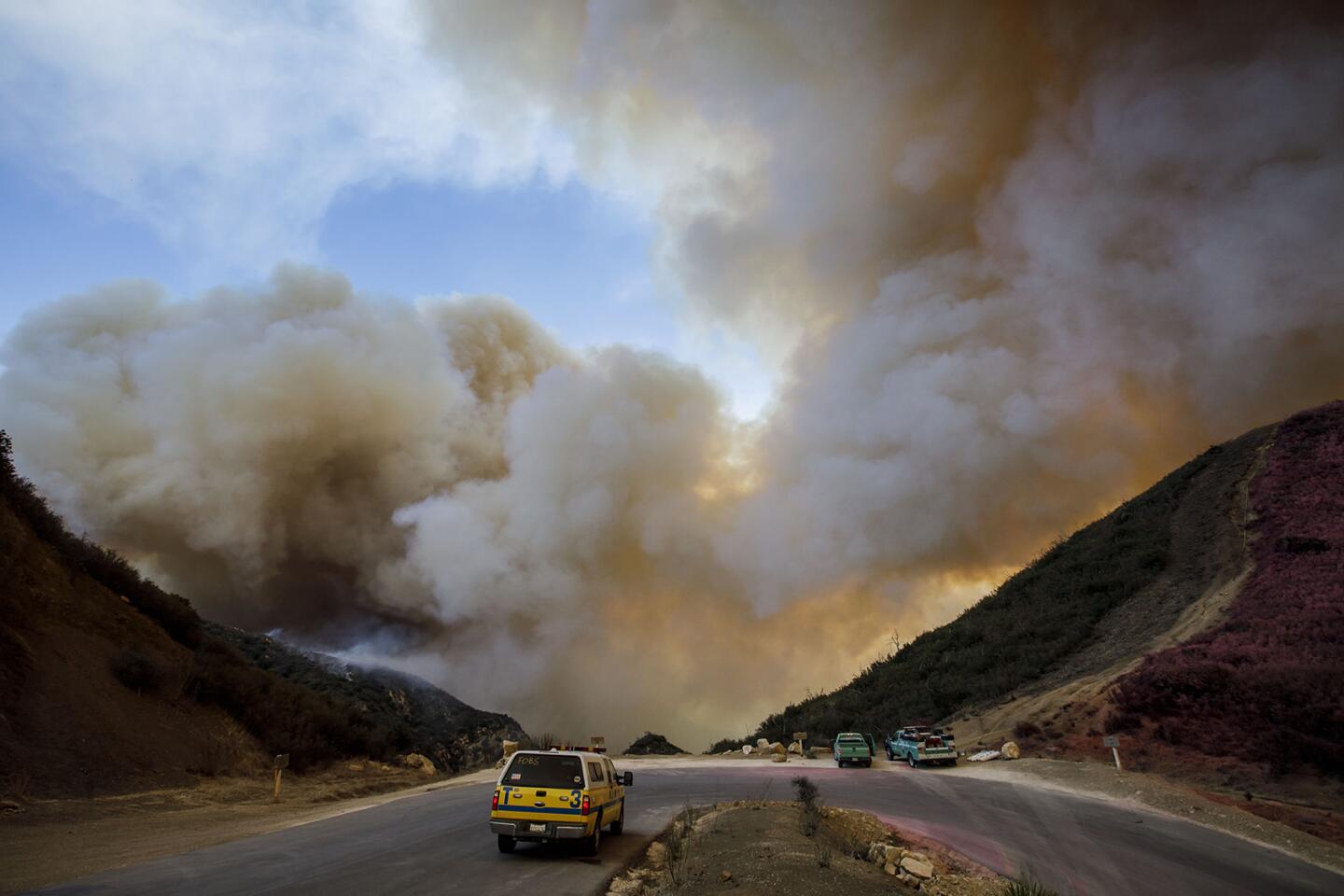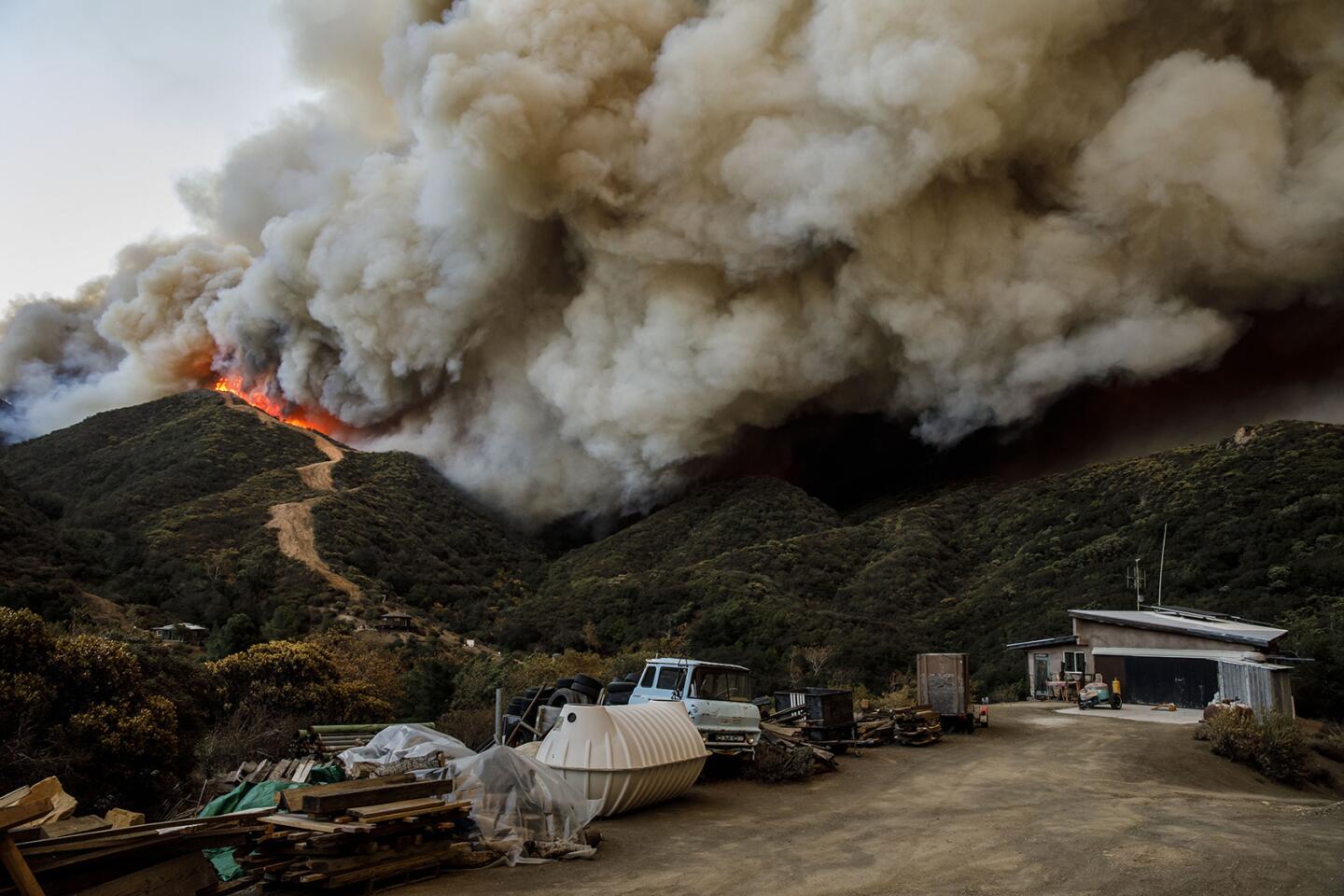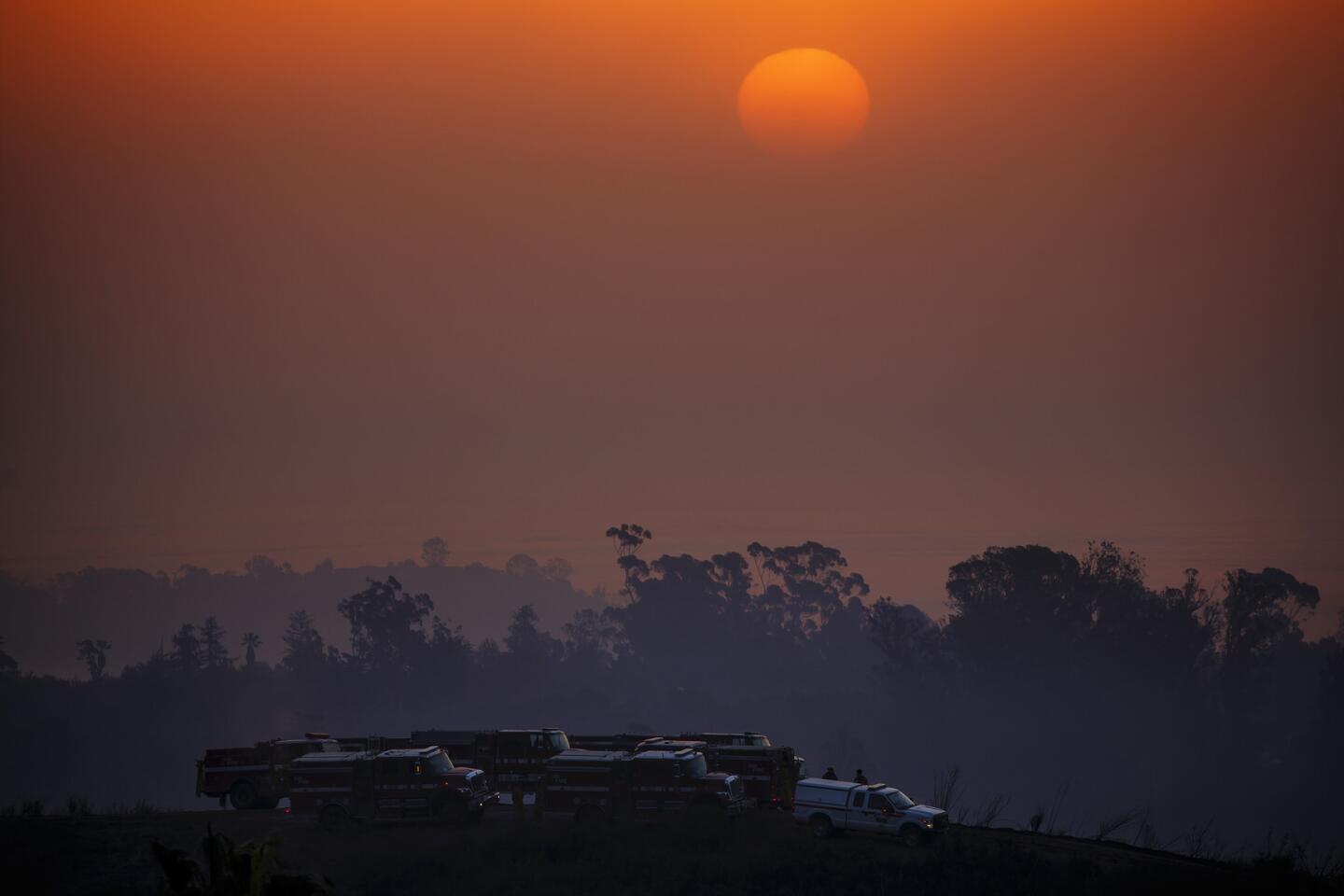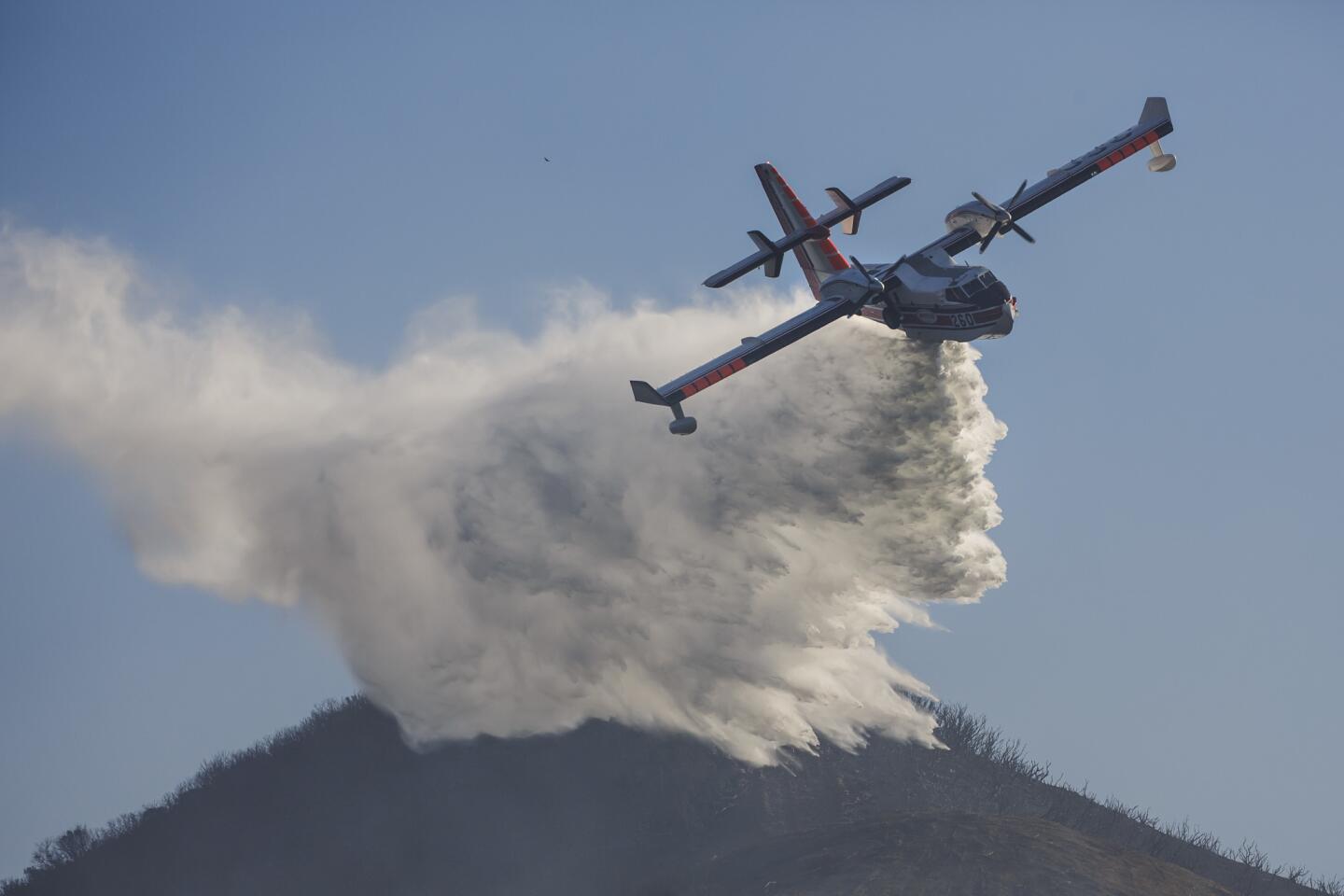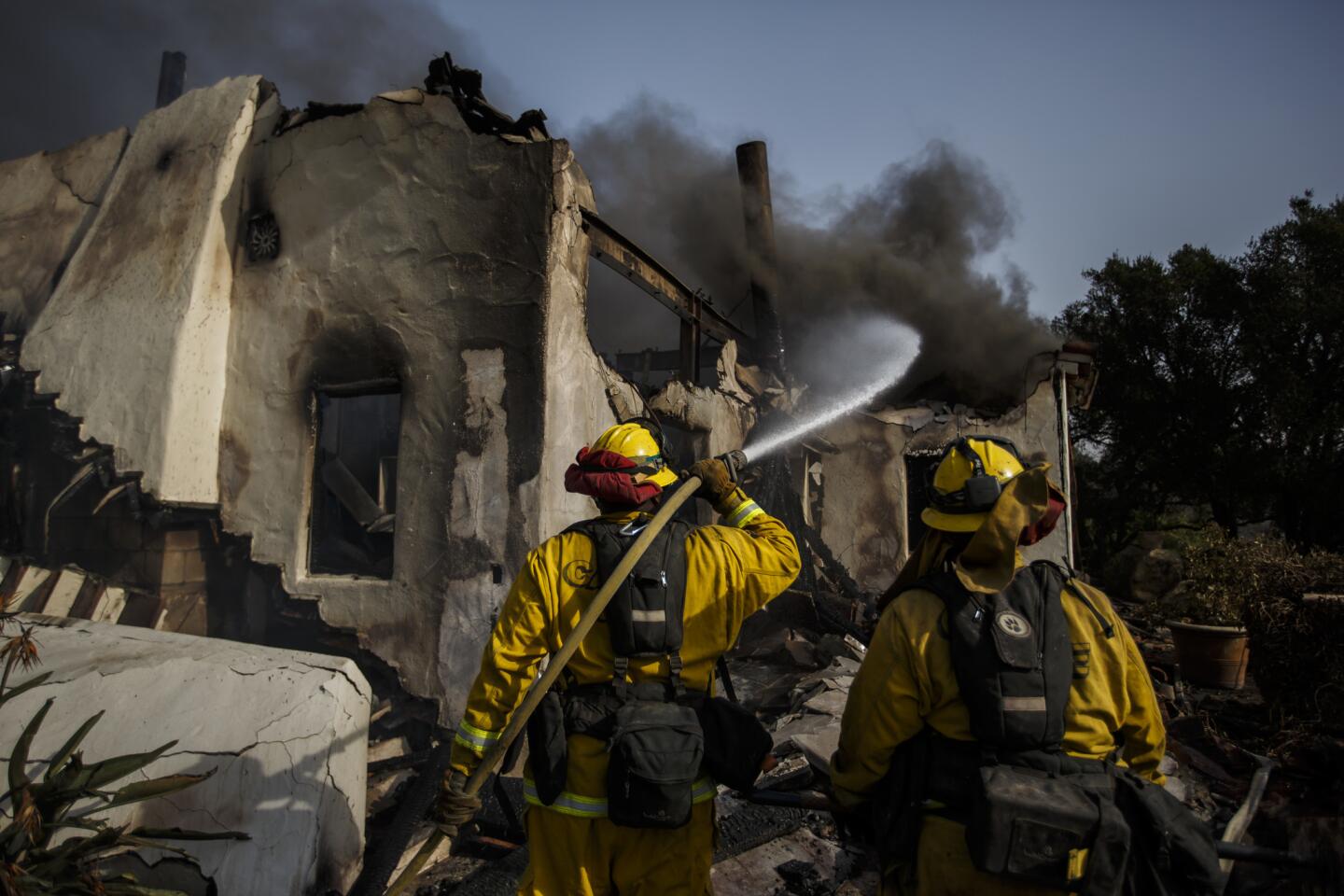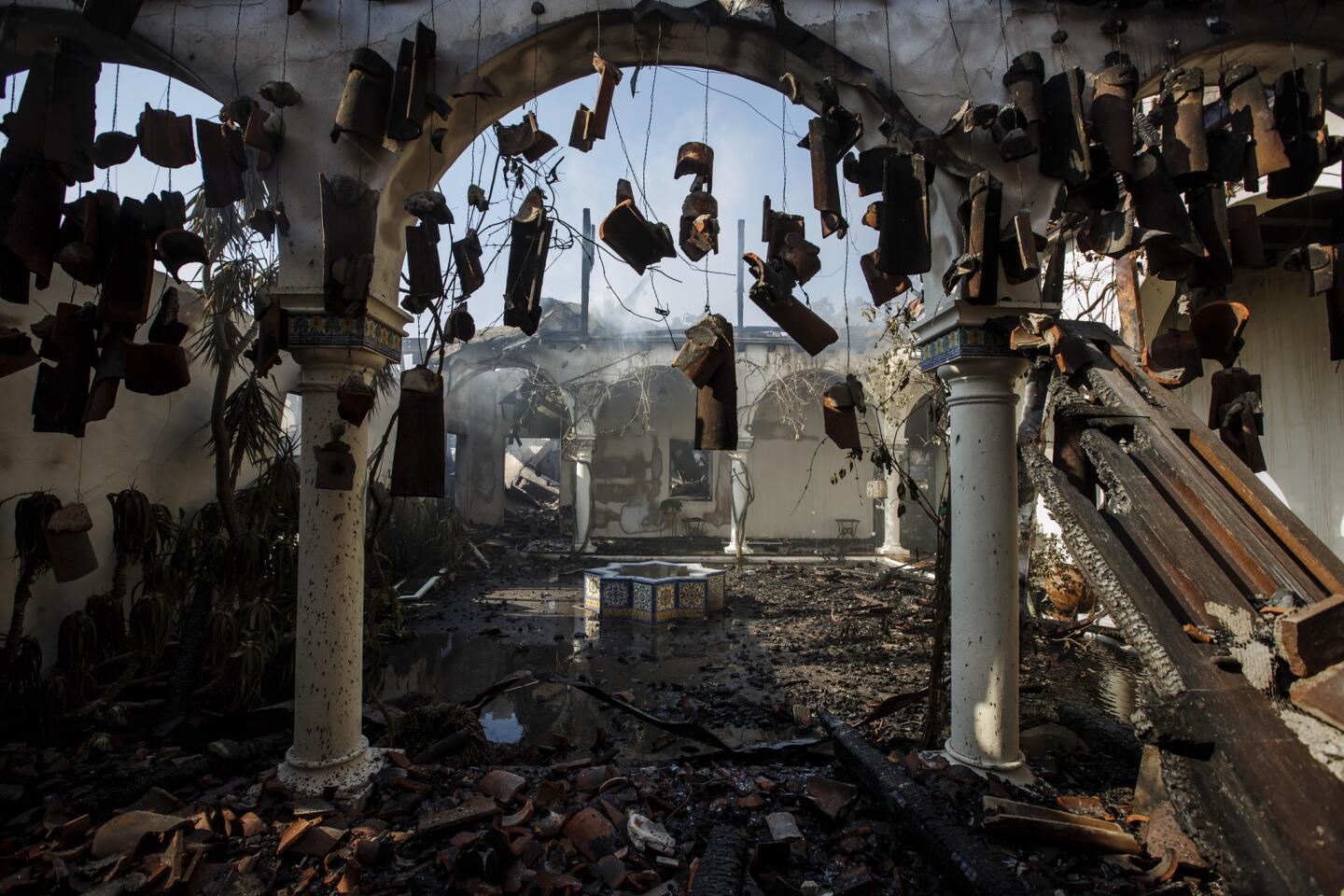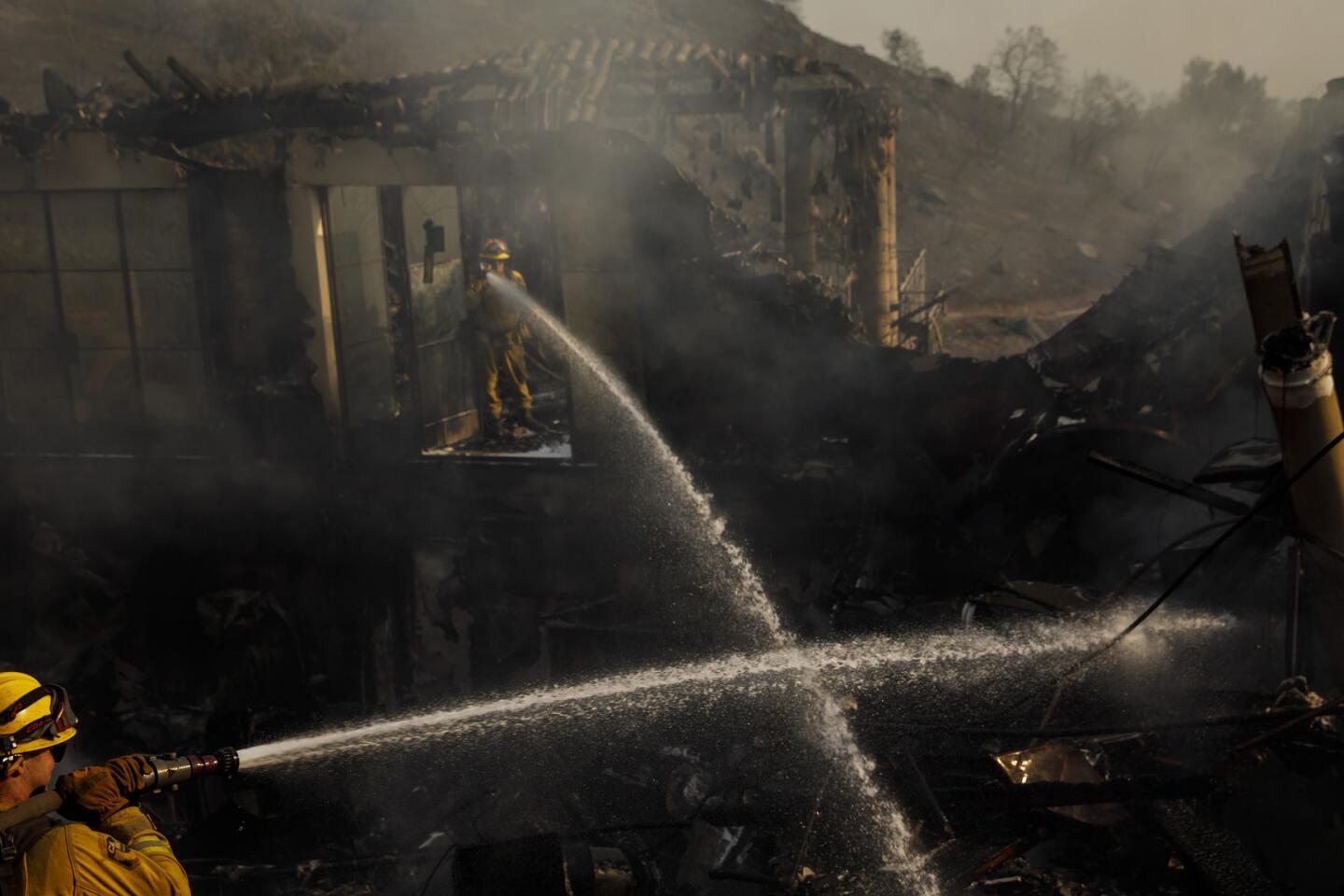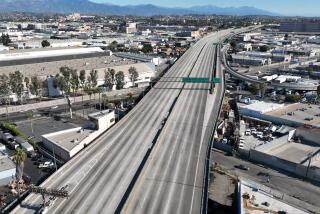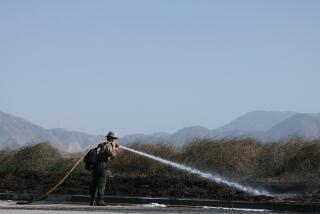The search for causes behind Southern California’s wildfires now includes witness reports of a snapped line on a high-voltage transmission tower in Little Tujunga Canyon, sending off sparks as it whipped high overhead.
The incident occurred at the start of the Creek fire, which burned more than 60 homes above Sylmar. That was one of five fires to besiege the Southland last week, destroying more than 1,000 structures and forcing hundreds of thousands to evacuate their homes.
For the record:
4:55 p.m. Dec. 15, 2017A version of this article published Dec. 13 said that a power pylon that some residents said was sparking at the beginning of the Creek fire near Sylmar was owned by Southern California Edison. The Times on Friday was able to gain access to the area, and signs on pylons in that area show they are owned by the Los Angeles Department of Water and Power.
Of those fires, officials have determined a firm cause of just one. The Los Angeles Fire Department said a cooking fire in a homeless encampment sparked the Skirball fire in Bel-Air.
Southern California Edison Co. announced Tuesday that California fire officials notified the utility that its equipment was under investigation as a possible cause of some of the fires.
It will probably take months for fire officials to determine the cause of the fires.
The owner of a small ranch on Little Tujunga Canyon Road said she was awakened early Dec. 5 by a panicked call from her mother, who said sparks were coming off the steel pylon as a line came loose and “was smacking the hill.”
Looking outside, Gail Thackray said, she saw much the same scene: “There was fire concentrated over there and sparks coming off the pylon…. It spread each direction.” She raced out of their ranch with her mother and daughter, driving out through fire.
Thackray’s account, made to a Times reporter last week, corresponds with the general time and location of the reported start of the Creek fire, which to date has burned more than 15,600 acres in the San Fernando Valley and nearby foothills.
Other fires include the Thomas, which started Dec. 4 in Ventura County and now is the fifth-largest fire in modern California history at more than 237,000 acres. It has destroyed 921 structures and claimed one life, a 70-year-old woman who died in a vehicle crash along an evacuation route.
California Department of Forestry and Fire Protection officials have released no information on their investigations into the start of those fires.
The fires began amid high Santa Ana winds that fanned flames to towering heights, creating extreme fire behavior that repeatedly forced firefighters to pull back. On the night of the Creek fire, Thackray’s mother, who lived in a small house on the ranch, was awakened by the sound of tree branches slapping against her windowpanes.
1/73
John Bain and Brandon Baker try to stop a fire from burning a stranger’s home in Ventura.
(Marcus Yam / Los Angeles Times) 2/73
A brush fire moving with the wind sends embers all over residential neighborhoods north of Ventura.
(Marcus Yam / Los Angeles Times) 3/73
A family packs up and evacuates as a brush fire gets closer to their home in Ventura.
(Marcus Yam / Los Angeles Times) 4/73
John Bain and his friends, all from Camarillo, came to help as brush fires move quickly through residential neighborhoods in Ventura.
(Marcus Yam / Los Angeles Times) 5/73
Strangers band together to help put out a palm tree on fire and stop it from burning homes.
(Marcus Yam / Los Angeles Times) 6/73
The Hawaiian Gardens apartments burn in Ventura.
(Michael Owen Baker / For the Times) 7/73
Residents help with the fire attack on Buena Vista Street in Ventura.
(Michael Owen Baker / For the Times) 8/73
Residents watch the Thomas fire on Prospect Street in Ventura.
(Michael Owen Baker / For the Times) 9/73
Firefighters are deployed to battle the fire in a Ventura neighborhood.
(Marcus Yam / Los Angeles Times) 10/73
A chimney is all that stands of a home as a brush fire continues to threaten other homes in Ventura.
(Marcus Yam / Los Angeles Times) 11/73
Remnants of a home as a brush fire continues to threaten other homes in Ventura.
(Marcus Yam / Los Angeles Times) 12/73
A home burns on a hillside overlooking Ventura.
(Marcus Yam / Los Angeles Times) 13/73
Palms are consumed in the Thomas fire.
(Marcus Yam / Los Angeles Times ) 14/73
Emma Jacobson, 19, center, gets a hug from a neighbor after her family home was destroyed by fire in Ventura.
(Marcus Yam / Los Angeles Times) 15/73
Olivia Jacobson, 16, wipes tears as she looks at her family’s home, destroyed by the brush fire on Island View Drive in Ventura.
(Marcus Yam / Los Angeles Times) 16/73
Aerial view of the Thomas fire in Ventura County.
(Brian van der Brug / Los Angeles Times) 17/73
Noah Alarcon carries a cage with the family cat while evacuating from Casitas Springs.
(Michael Owen Baker / For the Times) 18/73
Smoke from the Thomas fire crosses over Lake Casitas near Ojai.
(Michael Owen Baker / For the Times) 19/73
A Ventura County firefighter battles a blaze on Cobblestone Drive near Foothill Road in Ventura.
(Al Seib / Los Angeles Times) 20/73
Ventura County Firefighter Aaron Cohen catches his breath after fighting to save homes along Cobblestone Drive near Foothill Road in Ventura.
(Al Seib / Los Angeles Times) 21/73
Aerial view of homes burned to the ground in the Thomas fire in Ventura County.
(Brian van der Brug / Los Angeles Times ) 22/73
A home between Via Baja and Foothill Road burns in Ventura.
(Al Seib / Los Angeles Times) 23/73
Amanda Leon and husband Johnny Leon watch as firefighters fight to save homes along Cobblestone Drive near Foothill Road in Ventura.
(Al Seib / Los Angeles Times) 24/73
Chino Valley firefighters fight to save a home along Cobblestone Drive near Foothill Road in Ventura.
(Al Seib / Los Angeles Times) 25/73
Embers continue to burn at sunset Tuesday in a home on Ridgecrest Court at Scenic Way in the Clearpoint neighborhood of Ventura.
(Al Seib / Los Angeles TImes) 26/73
A firefighter battles the Thomas fire along Highway 33 in Casitas Springs.
(Wally Skalij / Los Angeles Times) 27/73
Firefighters try to protect homes from the Thomas fire along Highway 33 in Casitas Springs.
(Wally Skalij / Los Angeles Times) 28/73
A firefighter battles the Thomas fire along Highway 33 in Casitas Springs.
(Wally Skalij / Los Angeles Times) 29/73
Edward Aguilar runs through the flames of the Thomas Fire to save his cats at his mobile home along Highway 33 in Casitas Springs in Ventura County.
(Wally Skalij / Los Angeles Times) 30/73
Jeff Lipscomb, left, Gabriel Lipscomb, 17, center, and Rachel Lipscomb, 11, look for items to recover from their burned home in Ventura.
(Marcus Yam / Los Angeles Times) 31/73
A traffic collision temporarily clogged lanes on the northbound 101 Freeway between Solimar and Faria Beaches as the Thomas fire burned in the hills.
(Al Seib / Los Angeles Times) 32/73
The Thomas fire burns towards the 101 Freeway and homes between Solimar and Faria Beaches.
(Al Seib / Los Angeles Times) 33/73
Fire personnel keep an eye on the Thomas fire on Toland Road near Santa Paula.
(Michael Owen Baker / For the Times) 34/73
A train on the Rincon coast passes a burning hillside from the Thomas fire.
(Michael Owen Baker / For the Times) 35/73
The Thomas fire burns along the 101 Freeway north of Ventura on Wednesday evening.
(Wally Skalij / Los Angeles Times) 36/73
A firefighter battles the Thomas fire in the town of La Conchita early Thursday.
(Wally Skalij / Los Angeles Times) 37/73
A resident cries as the Thomas fire approaches the town of La Conchita early Thursday.
(Wally Skalij / Los Angeles Times) 38/73
Burned palm trees are left standing between the 101 Freeway and Faria Beach as the Thomas fire reaches the Pacific Ocean.
(Al Seib / Los Angeles Times) 39/73
Firefighters battle Thursday to protect the resort city of Ojai from encroaching flames.
(Marcus Yam / Los Angeles Times) 40/73
Casey Rodriquez helps a friend move belongings after the Thomas Fire destroyed most of an apartment building on North Kalarama in Ventura.
(Wally Skalij / Los Angeles Times) 41/73
A burnt-out bus near Maripoca Highway.
(Marcus Yam / Los Angeles Times) 42/73
The Thomas fire burns in the Los Padres National Forest, near Ojai.
(Marcus Yam / Los Angeles Times) 43/73
A huge plume of smoke rises north of Ventura as seen Sunday afternoon from the Ventura pier, as the Thomas fire threatens parts of Carpenteria and Montecito.
(Al Seib / Los Angeles Times) 44/73
The Thomas Fire burns in the Los Padres National Forest, near Ojai, Calif. on Friday.
(Marcus Yam / Los Angeles Times) 45/73
Residents react as they watch the Thomas Fire burn in the hills above La Conchita at 5 am Thursday moning.
(Wally Skalij / Los Angeles Times) 46/73
Mary McEwen and husband Dan Bellaart prepare to evacuate their home on Toro Canyon Road in Montecito as the Thomas fire burns.
(Mel Melcon / Los Angeles Times) 47/73
Carpenteria resident Chris Gayner, right, photographs a plane in the hills of Carpenteria.
(Mel Melcon / Los Angeles Times) 48/73
From left, residents Michael Desjardins, his neighbor Patty Rodriguez, daughter Mikayla, wife Veronica, mother in law Amanda Buzin, and son Mikey keep an eye on the Thomas fire in Carpenteria.
(Mel Melcon / Los Angeles Times) 49/73
Mary McEwen cheers as she sees fire crews make their way up a hill past her home on Toro Canyon Rd. in Montecito.
(Mel Melcon / Los Angeles Times) 50/73
Dan Bellaart and wife Mary McEwen comfort each other in the backyard of their home that includes an avocado ranch on 9 acres of land on Toro Canyon Road in Montecito, as the Thomas fire burns in the background.
(Mel Melcon / Los Angeles Times) 51/73
Carpinteria resident Jay Molnar, 55, mouth and nose protected against the smoke, views flames glowing in the hills above the city on Dec. 11, 2017.
(Mel Melcon / Los Angeles Times) 52/73
Sacramento firefighters battle a blaze in Toro Canyon in Carpenteria at dusk Tuesday.
(Al Seib / Los Angeles Times) 53/73
Josh Acosta, superintendent with Fulton Hotshots looks for ways to fight fire consuming a structure threatening two homes high up Toro Canyon in Carpenteria at dusk Tuesday.
(Al Seib / Los Angeles Times) 54/73
A motorcade passes on tHighway 126 carrying the body of a Cal Fire engineer Cory Iverson, who died Thursday morning while battling the Thomas Fire.
(Al Seib / Los Angeles Times) 55/73
Santa Paula City officials, Police and Firefighters salute from a bridge as a motorcade passes on the Santa Paula Freeway 126 carrying the body of a Cal Fire engineer Cory Iverson.
(Al Seib / Los Angeles Times) 56/73
Forest Service crews cut and clear dense brush for contingency lines off of East Camino Cielo in the Santa Ynez Mountains above Montecito and Santa Barbara to help stop the Thomas fire from advancing.
(Al Seib / Los Angeles Times) 57/73
A hotshot crew from Ojai marches towards their assignment to protect structures on East Mountain Drive in Montecito.
(Marcus Yam / Los Angeles Times) 58/73
Firefighters monitor the flames Saturday from a staging area near Parma Park in Montecito.
(Marcus Yam / Los Angeles Times) 59/73
Flames slowly make their way down a valley behind a home in Montecito.
(Marcus Yam / Los Angeles Times) 60/73
Flames whip around power lines as they move through Sycamore Canyon on Saturday, threatening structures in Montecito.
(Marcus Yam / Los Angeles Times) 61/73
Smoke billows over Santa Barbara as the Thomas Fire continues to threaten the area on Saturday.
(Robert Gauthier / Los Angeles Times) 62/73
Bill Shubin, deputy fire chief of the Santa Rosa Fire Department checks on flames burning near homes north of East Mountain Drive in Montecito.
(Marcus Yam / Los Angeles Times) 63/73
A fire truck pulls responds to fires burning near homes on East Mountain Drive in Montecito.
(Marcus Yam / Los Angeles Times ) 64/73
Brian Good, from US Forest Service, leans forward against the wind, and holds up a Kestrel to measure wind speeds up to 50 mph on Gibraltar Road in Montecito.
(Marcus Yam / Los Angeles Times) 65/73
A plume of smoke moves south as winds as high as 50 mph blow down Gibraltar Road on the west fork of Cold Spring Trail in Montecito.
(Marcus Yam / Los Angeles Times) 66/73
Flames and a big plume of smoke threaten homes on Gibraltar Road near Gibraltar Rock, outside Montecito.
(Marcus Yam / Los Angeles Times) 67/73
The sun rises as fire crews prepare for another day of fighting the Thomas Fire, in Montecito, Calif., on Sunday.
(Marcus Yam / Los Angeles Times) 68/73
An aircraft makes a water drop over a hot spot up in the mountain range at Gibraltar Rock near Montecito, Calif. on Sunday.
(Marcus Yam / Los Angeles Times) 69/73
Humboldt County firefighters Bobby Gray, left, hoses down smoldering flames inside a destroyed home, as Kellee Stoehr, right looks on, after the Thomas Fire burned in Montecito, Calif. on Sunday.
(Marcus Yam / Los Angeles Times) 70/73
A home on Park Hill Lane was destroyed by the Thomas fire in Montecito, Calif.
(Marcus Yam / Los Angeles Times ) 71/73
Humboldt County firefighters Lonnie Risling, left, and Jimmy McHaffie, right, spray down smoldering fire underneath the rubble of a home that was destroyed by the Thomas Fire, in Montecito, Calif., Sunday.
(Marcus Yam / Los Angeles Times) 72/73
Fire crews help the Behrman family retrieve their family’s personal belongings out of their burned home, in Montecito, Calif., on Sunday.
(Marcus Yam / Los Angeles Times) 73/73
In the foreground of the ridges that were burned by the Thomas Fire, Rusty Smith stands outside his home that survived the flames that were kicked up by Saturday’s wind event and threatened his home in Flores Flats on Gibraltar Road, near Montecito.
(Marcus Yam / Los Angeles Times) The closest weather station, atop a nearby ridge, recorded wind gusts as high as 73 mph at 2:55 a.m. Dec. 5 — 1 mile per hour below the sustained wind speed for a Category 1 hurricane.
The power line Thackray identified is owned by the Los Angeles Department of Water and Power. . The utility last week said it believed its equipment had been cleared of involvement in the Thomas and Creek fires. But in its Tuesday statement, the utility said it “believes the investigations now include the possible role of its facilities.”
A spokesman for the utility declined to comment on Thackray’s description of events. He referred questions to the state fire agency.
On Wednesday, Cal Fire investigators were present on Little Tujunga Canyon Road. They said they were in the area interviewing residents about what they saw the night of the fire and declined to comment further.
One homeowner, Maria Kirkland, said investigators asked her specifically if she had seen the tower sending out sparks.
“To be honest, I don’t remember sparking,” Kirkland said.
The California Public Utilities Commission did not immediately respond to requests for copies of incident reports the utility would be required to file with the regulatory agency.
Thackray said the slopes of Little Tujunga Canyon surrounding them were already on fire by the time she, her mother and 12-year-old daughter fled their small ranch. There was no time to gather up her dog or open the gates for her ponies, Mr. Chips and Black Beauty. Their bodies would be found later, and her house burned to the ground, leaving little more than piles of rubble.
But one horse, Swagman, jumped the fence. There was no sign of him when Thackray returned, but her trainer later found Swagman among the rescued horses at an equine center.
Determining the cause of the fire has major financial implications.
Though the cause of October’s devastating Tubbs fire in Santa Rosa is still under investigation, numerous residents who lost homes have sued Pacific Gas & Electric Co., alleging power lines downed by winds sparked the blaze. PG&E has suggested the fire might have been caused by third-party power lines not owned by the utility.
Downed power lines have sparked massive California wildfires in the past, and utilities from San Diego to Northern California have been on the hook for millions of dollars.
Southern California Edison ended up paying the state $37 million in fines for the 2007 Malibu Canyon fire.
PG&E has also faced blame. After Cal Fire investigators found the utility responsible for the 70,000-acre Butte fire that killed two people in 2015, the state attorney general sued the company for $87 million in related costs. That case, filed in April of this year, is ongoing.
brittny.mejia@latimes.com
Twitter: @Brittny_Mejia
paige.stjohn@latimes.com
Twitter: @paigestjohn

